After a week of sightseeing in Chongqing, I plan to take a Yangtze River cruise down the river to Nanjing, in order to enjoy the beautiful scenery on both sides of the Yangtze River and experience the river life of inland river cruise ships.
After searching online, I contacted "Xiao Bao" from the cruise booking center, whose real name is Ms. Wei Junhua.
She was very enthusiastic and provided a detailed introduction to the situation and characteristics of traveling by cruise ship. She listened carefully to our ideas and requirements, and sent relevant information in a timely manner. She is a patient, responsible, and highly skilled comrade!
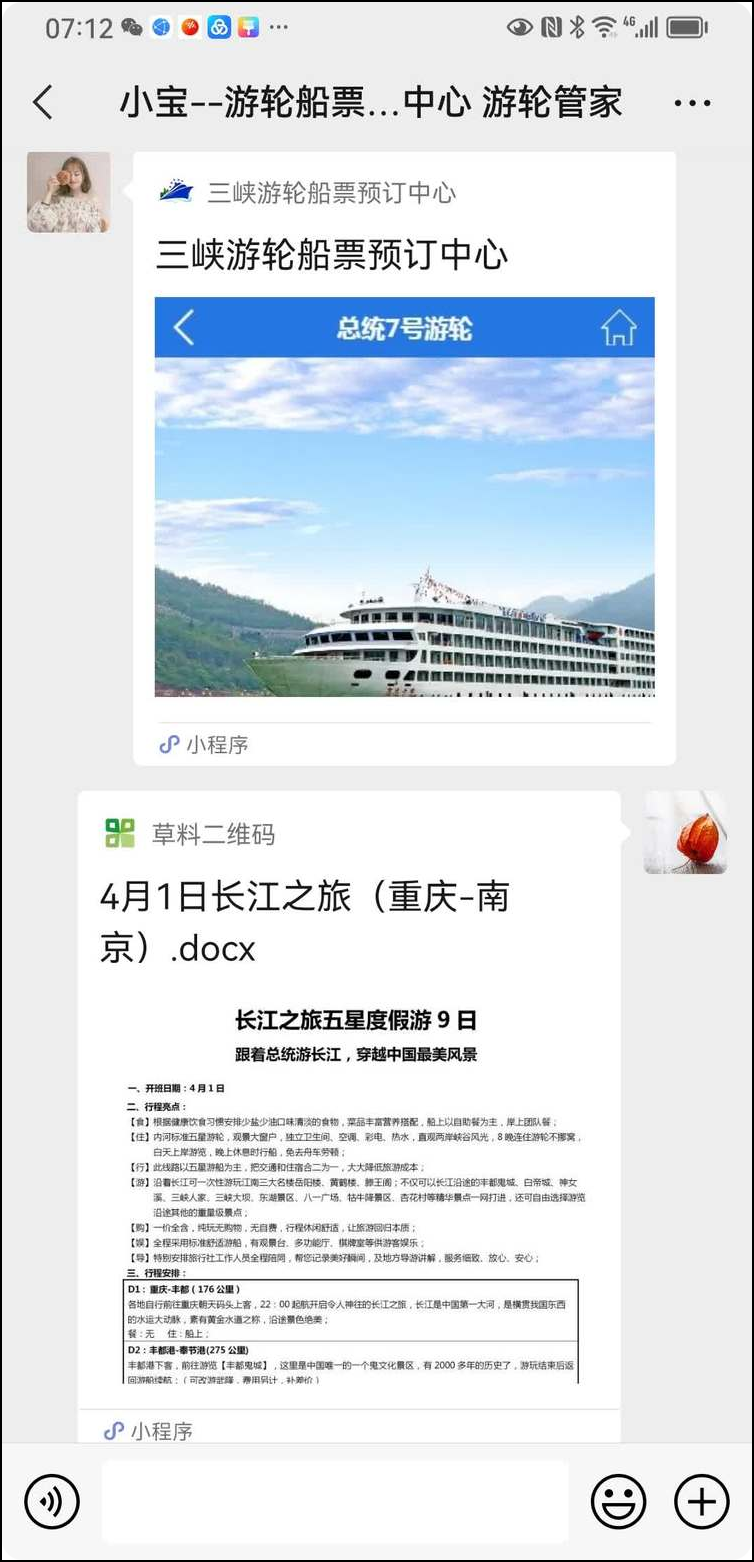
This is the operation of the cruise ship that resumed shortly after XX passed, and there are many random situations.
After online booking and payment, and signing the contract online, there were several changes, and it was finally determined that
President's 6th Three Gorges CruiseExecute this time
9-day tourThe navigation mission.

Due to the current dry season of the Yangtze River this year, 10000 ton cruise ships are unable to enter Chongqing Chaotianmen Port. The ship owner has notified that they will gather at Chongqing Grand Theatre at 3 pm on April 1st and take a bus together to Fengdu Port to board the ship.
The Chongqing Grand Theatre, located at No. 2 East Wenhua Street, Jiangbei District, Chongqing, started construction on January 28, 2007 and was completed and put into use on September 6, 2009. It is a large-scale social and cultural facility that integrates opera, drama, concert performances, cultural and artistic exchanges, and multiple functions.
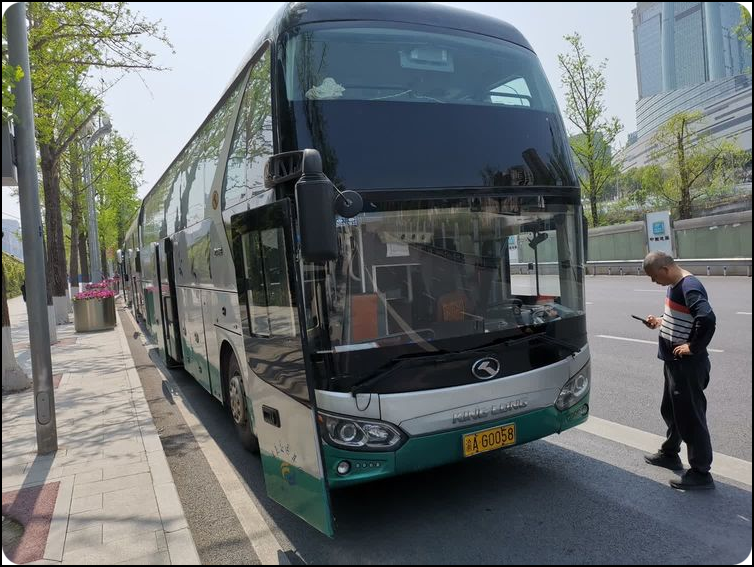
The distance from Chongqing to Fengdu is 176 kilometers by water and about 160 kilometers by car on the expressway.
The car arrived at Fengdu Port at 5:20 pm in the afternoon.

Fengdu Port
There are five docks in the old city of Fengdu. The first and second docks go down from the commercial street, the third dock focuses on the tourist dock, and the fifth dock is the Maliulin dock.
In the 1990s, people from Fengdu had to catch a boat to travel to Chongqing, Xingyi, and Gaozhen. With the changes of the times, automobile transportation, airports, high-speed trains, and high-speed railways continued to emerge in the reservoir area, and transportation became increasingly convenient. As a result, passenger ships gradually faded out of people's sight.
We arrived at Fengdu Port and saw the President's No. 6 cruise ship docked at the pier from a distance. We walked down multiple steps and jumped over a floating iron plate bridge before boarding.
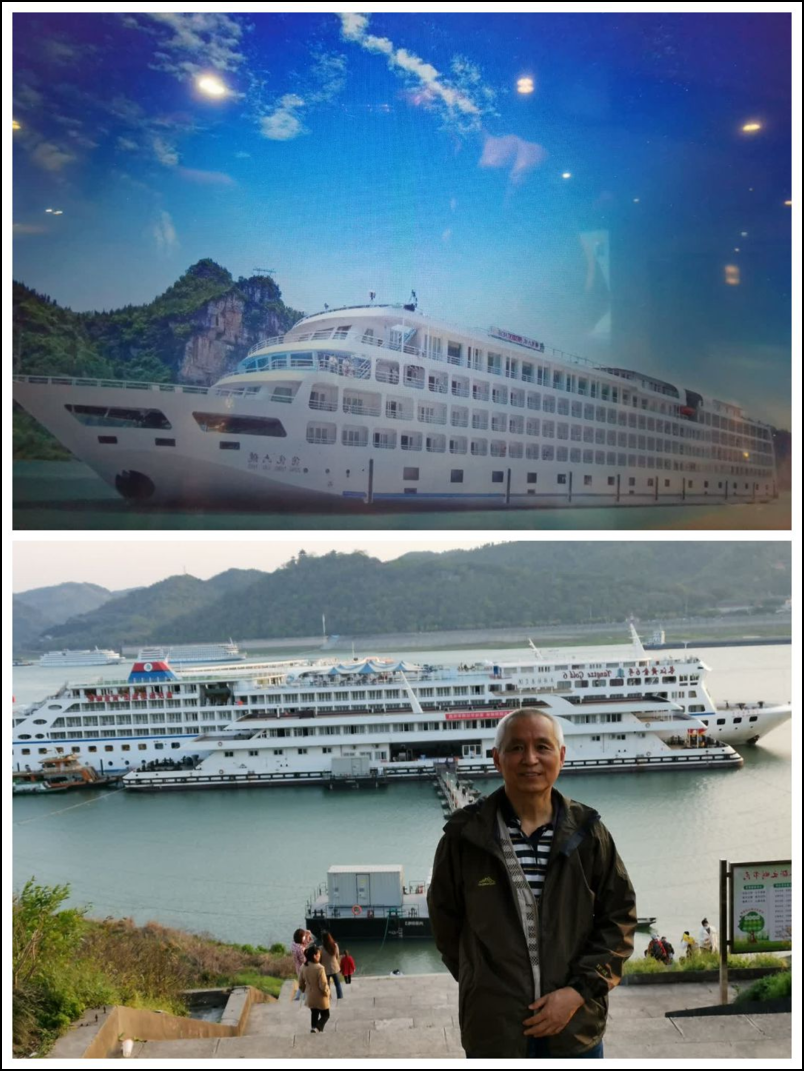 President's 6th Cruise
President's 6th CruiseBuilt according to five-star standards.
Total tonnage: 12000 tons; Captain 135.2 meters and ship width 19.6 meters. The speed is 26 kilometers per hour and the draft is 2.6 meters.
There are accommodation on deck 6, floors 1 to 5, with the first floor mainly accommodating crew and staff, and floors 2 to 5 mainly accommodating guest rooms of different levels.
There are 177 guest rooms and 354 passengers.
Room types: Standard Room, Executive Suite, Deluxe Suite, Presidential Suite.
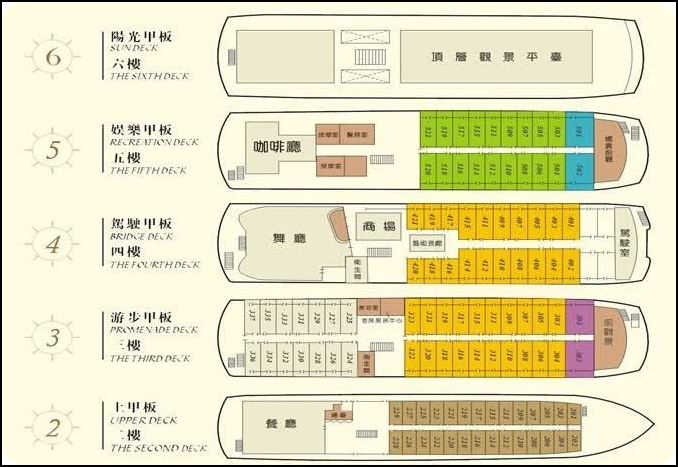 The auxiliary function compartments on board are:
The auxiliary function compartments on board are:6F: Sundeck, Sea View Sunshine Lounge, Yushanfang (Small Restaurant), Chess and Card Room, KTV Singing Room.
5F: General Club, Oscar Performing Arts, Chess and Card Room.
4F: Inner Bottle Painting Art Center, Embroidery Art Center.
3F: Internet cafe, Silk Art Center.
2F: Front Desk, Shangri La Restaurant (Grand Restaurant).
1F: Spa, sauna, gym, medical room, beauty salon.
In fact, tourists often only visit the front desk, the restaurant corresponding to the bedroom level, and the sixth deck.
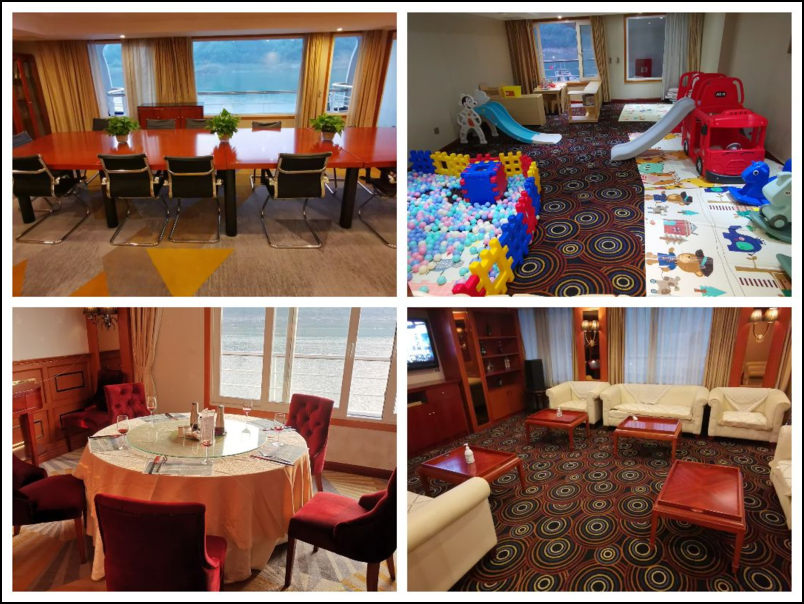
Children's entertainment room, conference room, reception room, etc. on the fifth floor.

Six level lounge and front deck
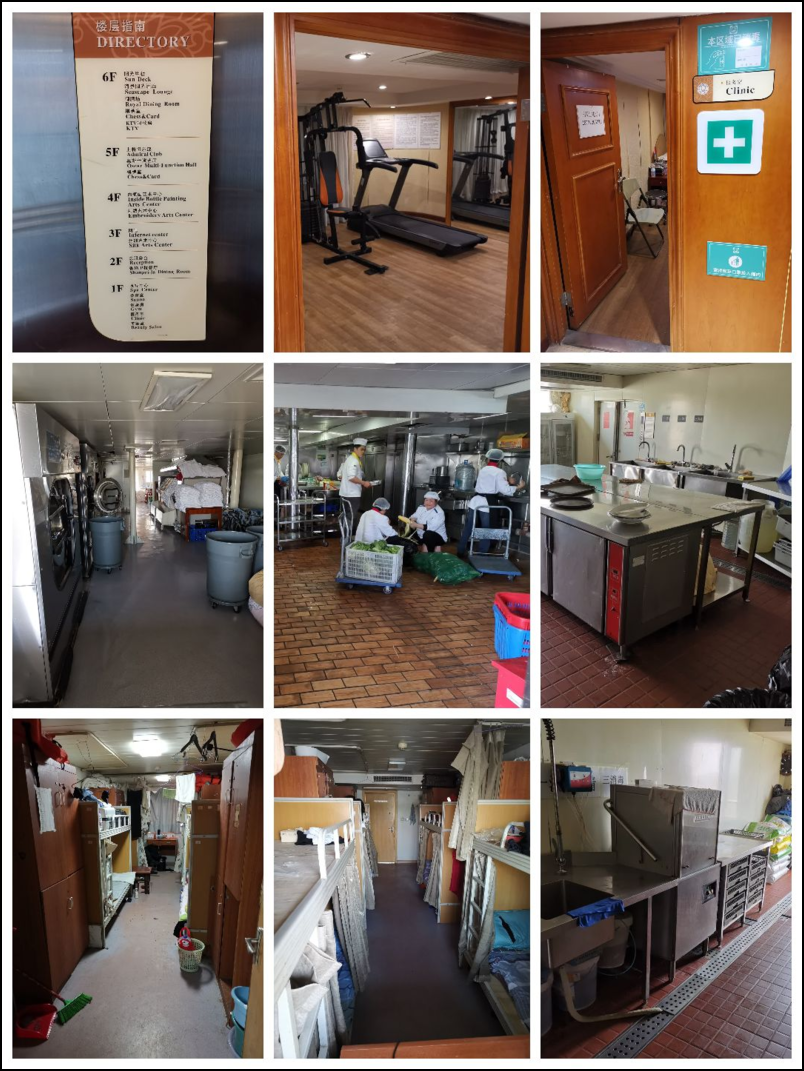
This is a condition of one layer.
The medical room is very small, the crew cabin is crowded, and the meal preparation room is very busy.
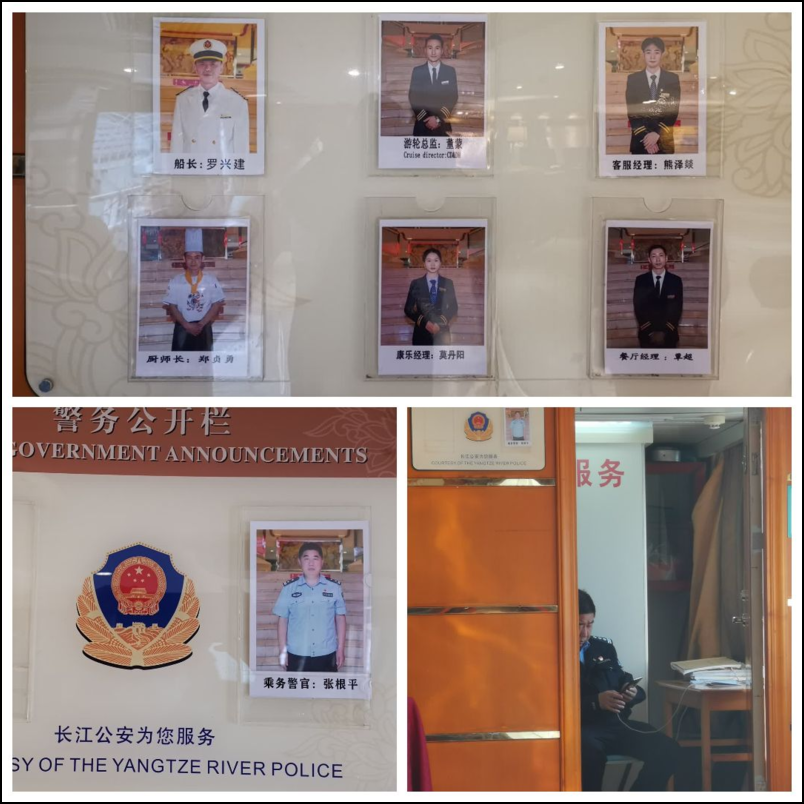
The leadership members of President 6 cruise ship are six: captain, cruise ship director, customer service manager, recreation manager, restaurant manager, and head chef.
There is a police officer with the rank of first level police inspector.
There are also two onboard photographers who take follow-up photos of tourists at scenic spots. Before the cruise ends, tourists select their favorite photos and quickly enlarge and print them out. Of course, fees are indispensable.
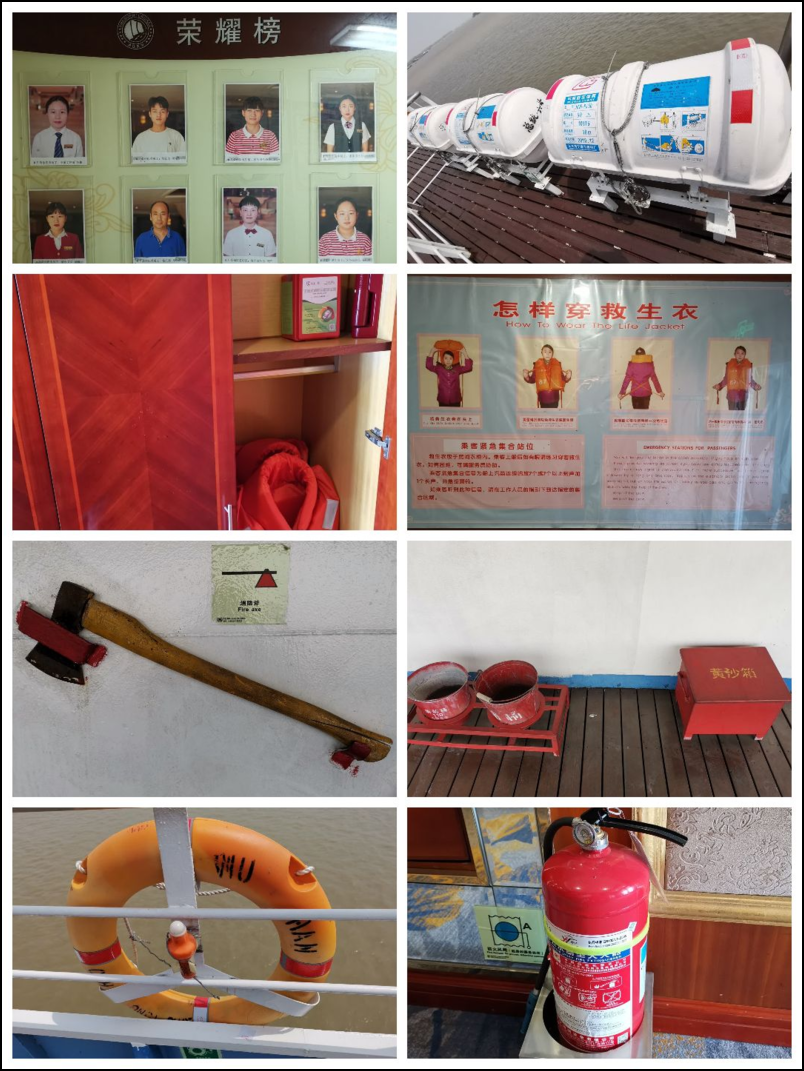
The life-saving equipment and fire-fighting facilities on board are relatively complete.
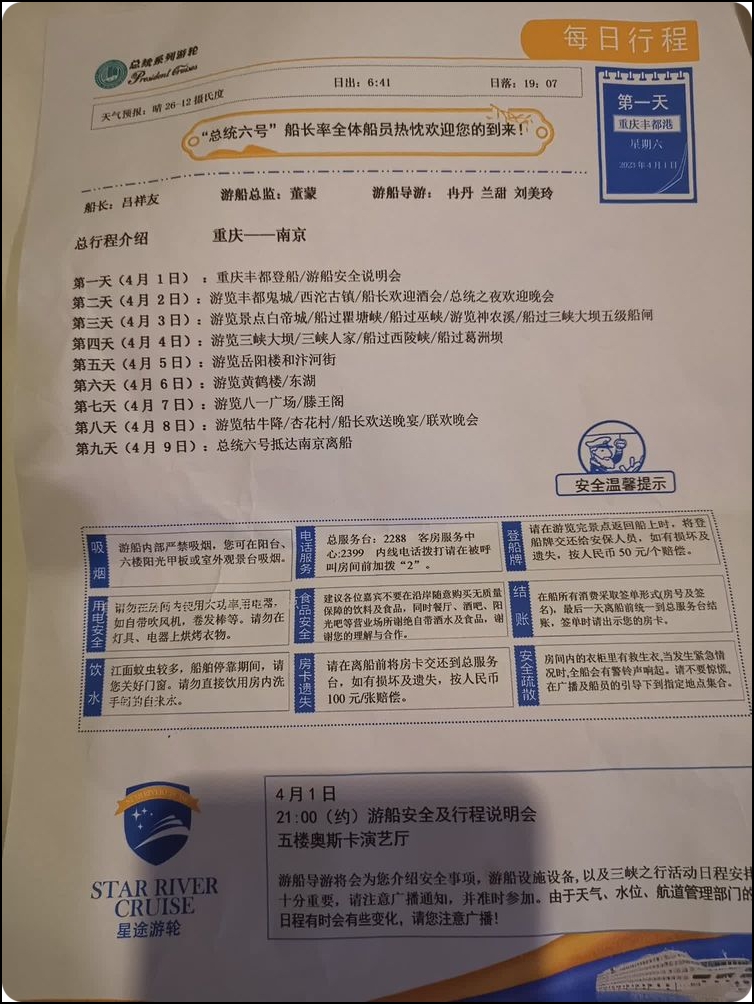
The first day of the President's Nine Day Tour on the Three Gorges Cruise
Two main things:
One is for tourists to board the ship and complete check-in procedures;
Secondly, from 9:15 pm to 45 pm, all tourists will have a meeting on the second floor, where a female crew member will introduce the ship's facilities, safety, itinerary, etc.
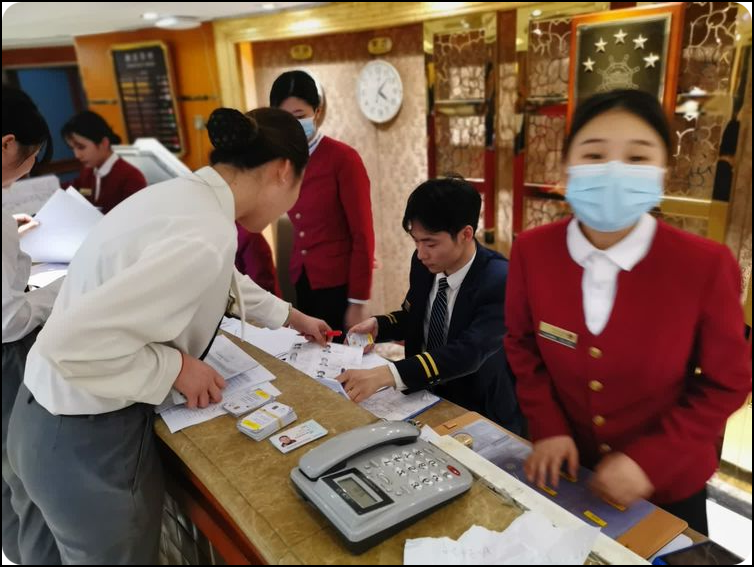
The busy situation of the service desk staff when tourists check in.
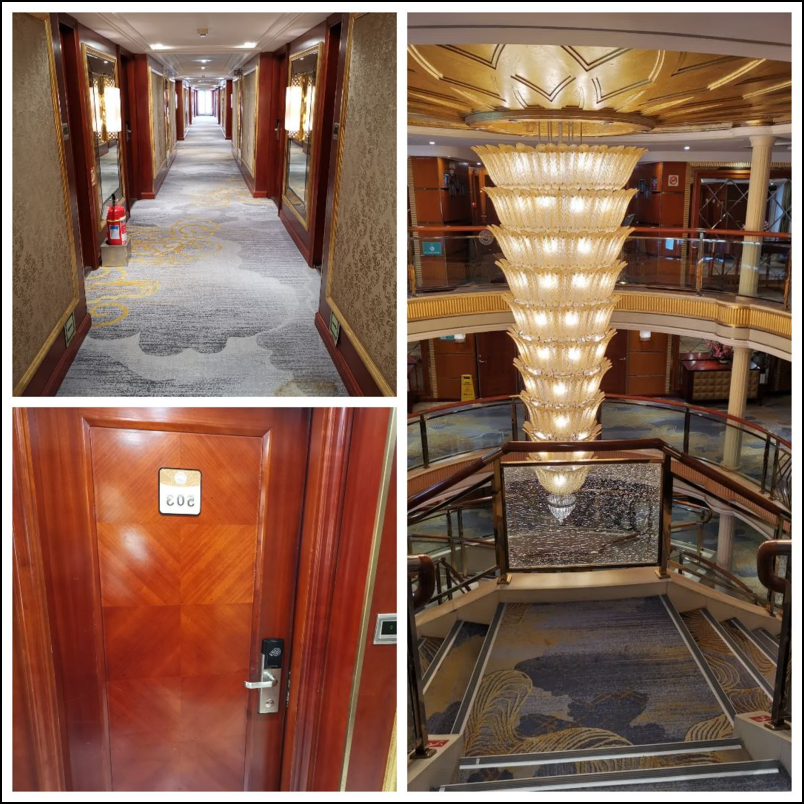
The condition of the fifth floor of the cruise ship
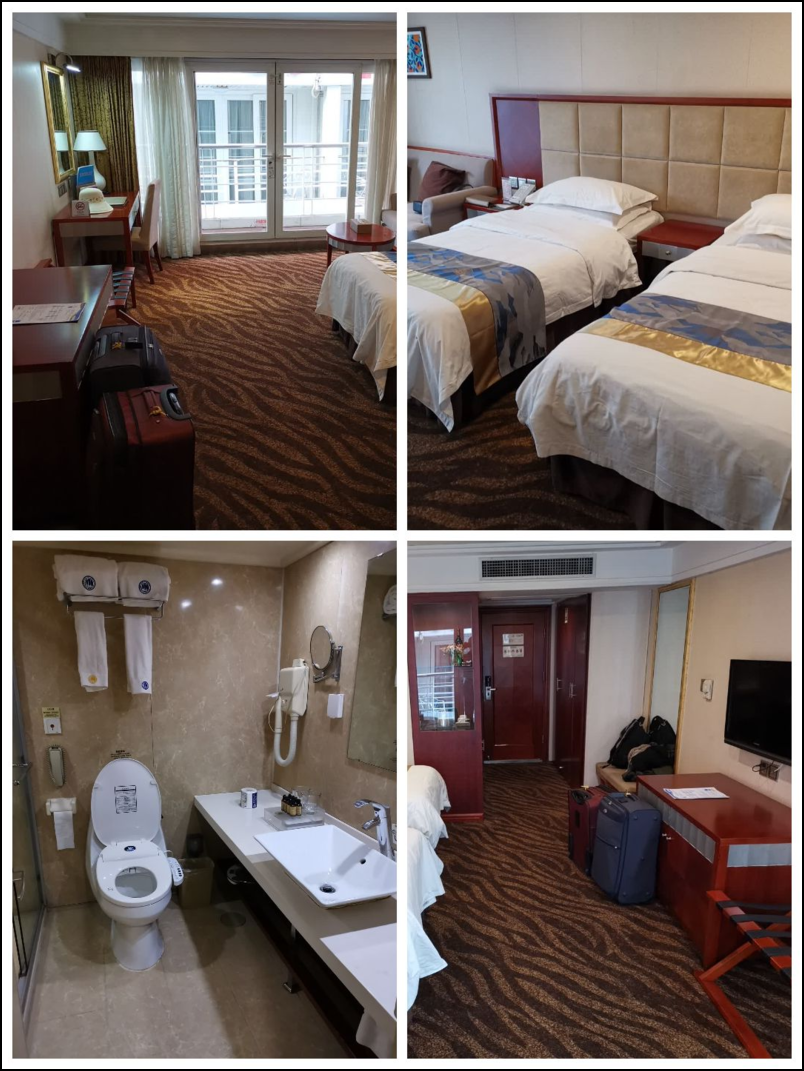
VIP glance at Executive Suite 503, with a total indoor area of 45 square meters including a balcony.
The waiter cleans the house every day and provides free and quantified red wine, small fruit plates, bagged coffee, tea, bottled water, canned cola, and Sprite.
The VIP in the executive suite also does not share WiFi, only the second floor main service area has it, but it is sometimes strong and sometimes weak, and the effect is poor.
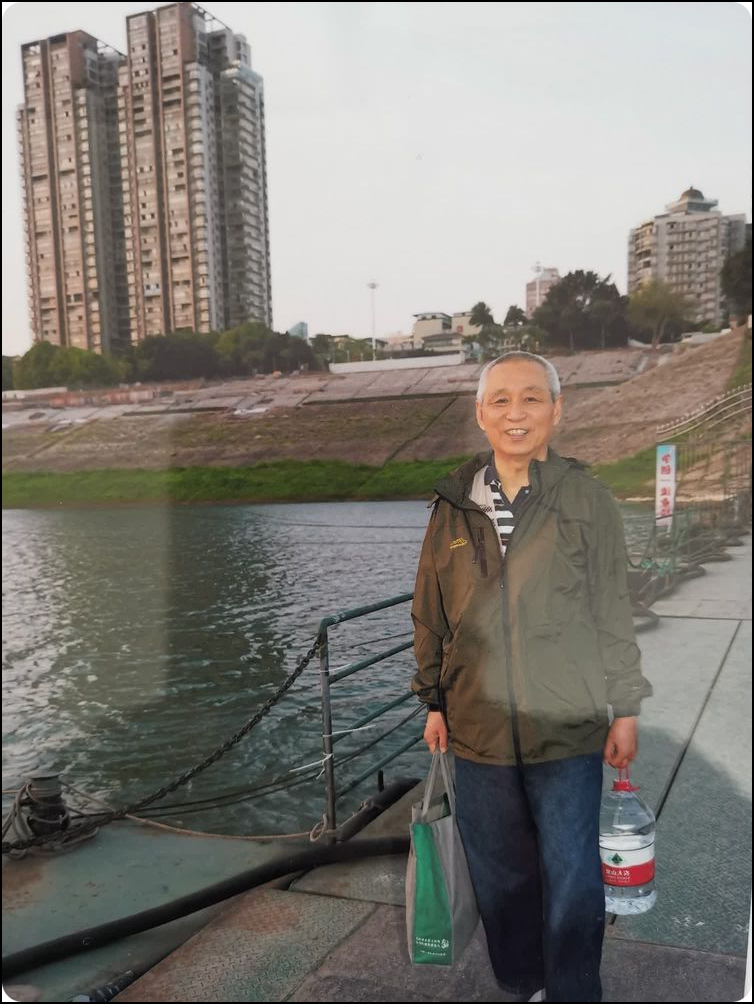
After completing the check-in procedures, take the elevator to VIP Executive Suite 503.
After settling in, considering that I had plenty of water and needed fruits, I obtained my departure permit and boarded the dock to the square in front of me to buy 10 pounds of fruit, agricultural three wheeled motorcycles, and a bucket of mineral water from the small supermarket across the street.
Return in half an hour, return the departure card and enter the cruise ship.
The two types of oranges I bought are freshly picked, very fresh, juicy and sweet, with a strong citrus aroma, and have a unique flavor compared to those sold in city fruit shops.
At 9:15 pm that evening, all tourists had a meeting in the large conference room on the fifth floor.
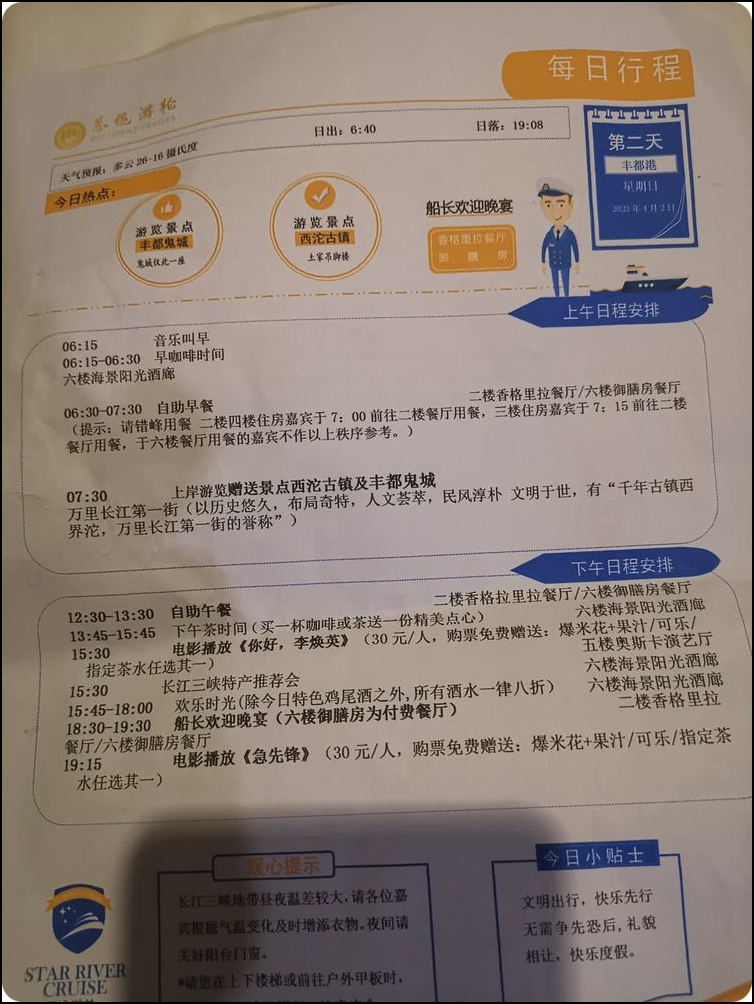
The second day of the President's Nine Day Tour on the Three Gorges Cruise
In the morning, visit Xituo Ancient Town and Fengdu Ghost City;
The captain held a welcome dinner tonight.
After waking up, go to the sixth deck to watch the morning mist on the river and have breakfast coffee.
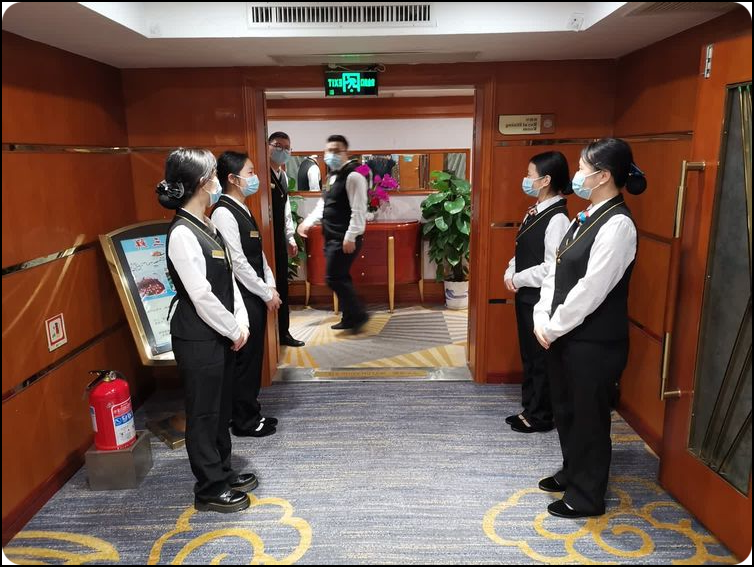
The six story restaurant (Imperial Kitchen) is only available for guests residing in executive suites or above.
Breakfast at the sixth floor restaurant
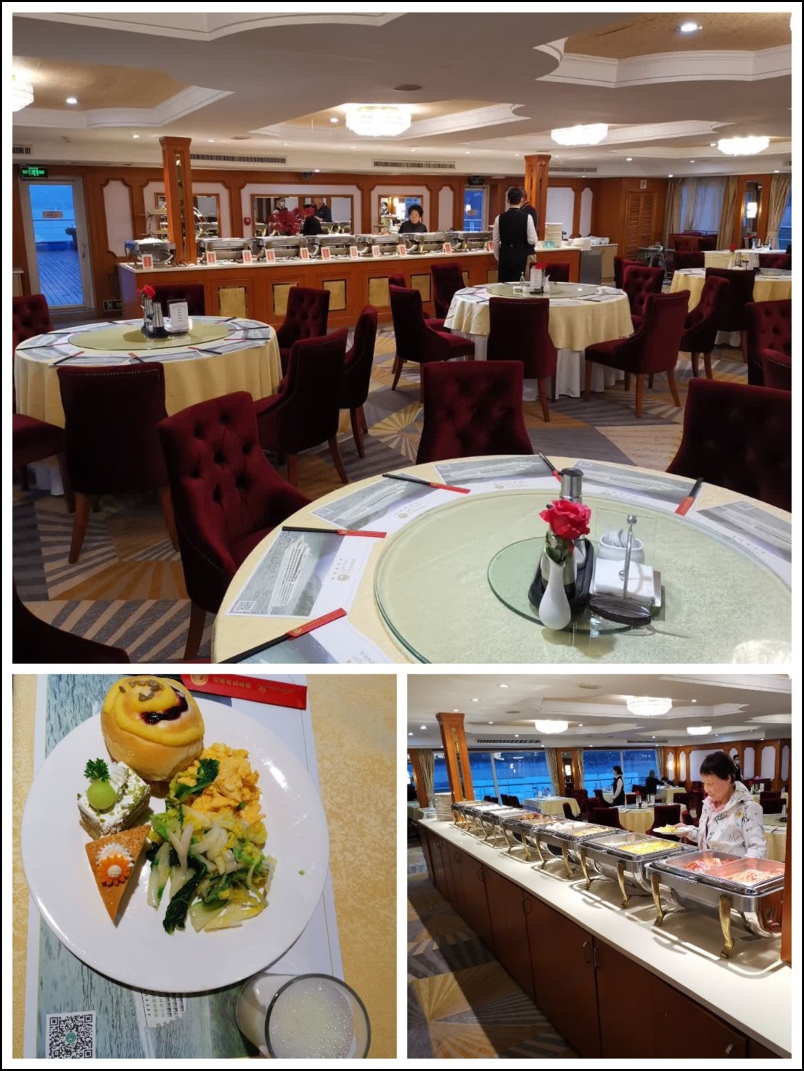
Take photos on the deck after breakfast
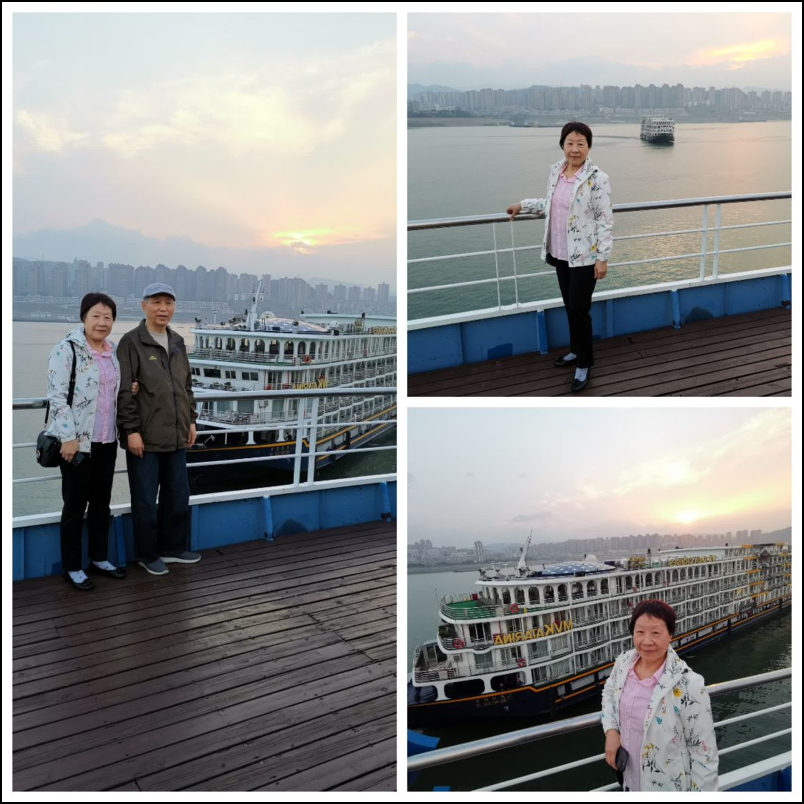
At 7:30 pm, the announcement was made that tourists should gather at the second floor restaurant. Tourists who went to Nanjing, Wuhan, and Yichang should form groups to go ashore for tourism.
When leaving the ship, the staff will issue a departure sign to each tourist.
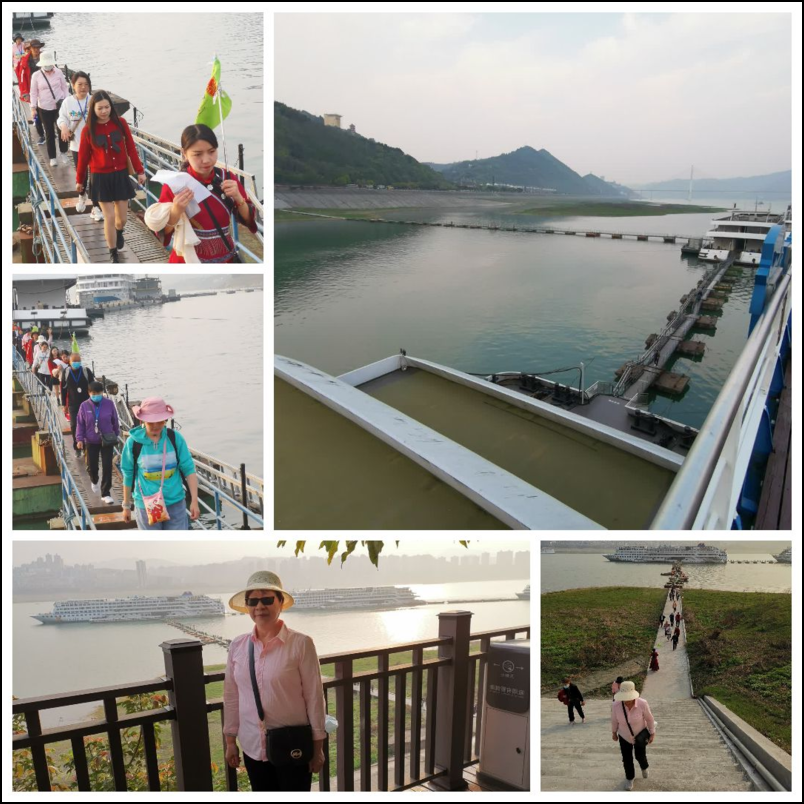
Boarding the dock with a Tujia female tour guide, tourists heading to Nanjing took bus No. 102 and drove for two hours to reach Xituo Ancient Town.
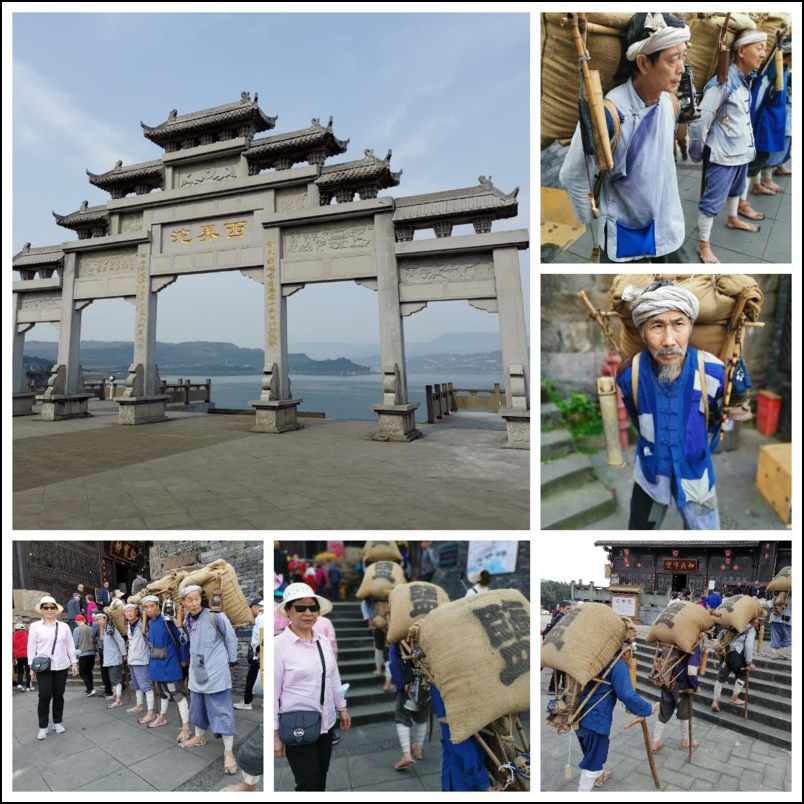 Xituo Ancient Town
Xituo Ancient TownLocated in Shizhu Tujia Autonomous County, Chongqing, formerly known as Xijie Tuo, it was formerly known as the "western boundary of Bazhou" and was named after its location on the south bank of the Yangtze River, known as Huishui Tuo. Xituo is under the jurisdiction of Shizhu County and is known as "stepping on three counties with one foot".
Xituo has a long history and culture. As early as the Qianlong period of the Qing Dynasty, this place was known for its abundant water and land trade, thriving fireworks, and resembling a swamp town.
Xituo Ancient Town prospers the city with salt and builds streets along the road, which is the starting point of the ancient Ba Yan Ancient Road. The main attractions include Yunti Street, Bayan Ancient Road, Shuimoxi Wetland Nature Reserve, etc.
Entering the ancient town, the first thing that catches the eye is dressing up as poor salt workers from the past.
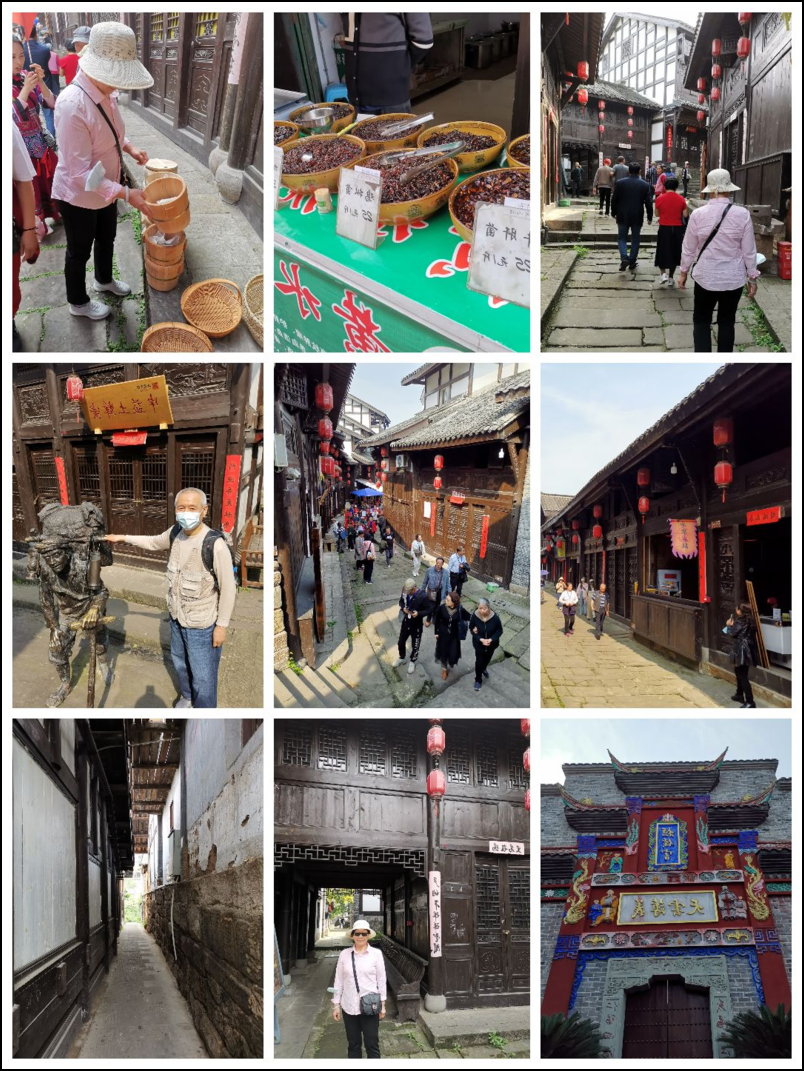 Zhenzhong Yunti Street
Zhenzhong Yunti StreetThe original length was about 2.5 kilometers, with 1314 stone steps. Because the street resembles a giant dragon, spiraling down from the mountaintop like a ladder, it is the only ancient town with a stepped street layout perpendicular to the Yangtze River.
On both sides of Yunti Street, there are layers of Tujia stilted houses. Climbing up to the top of the stairs and looking down, one can feel the distinct layers and unique artistic conception.
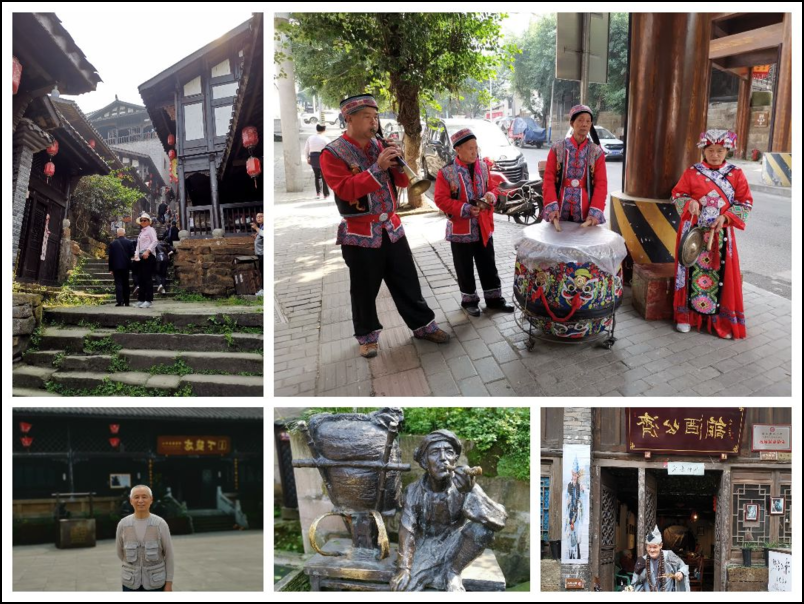
Street shops, statues, and performances make the ancient town full of vitality
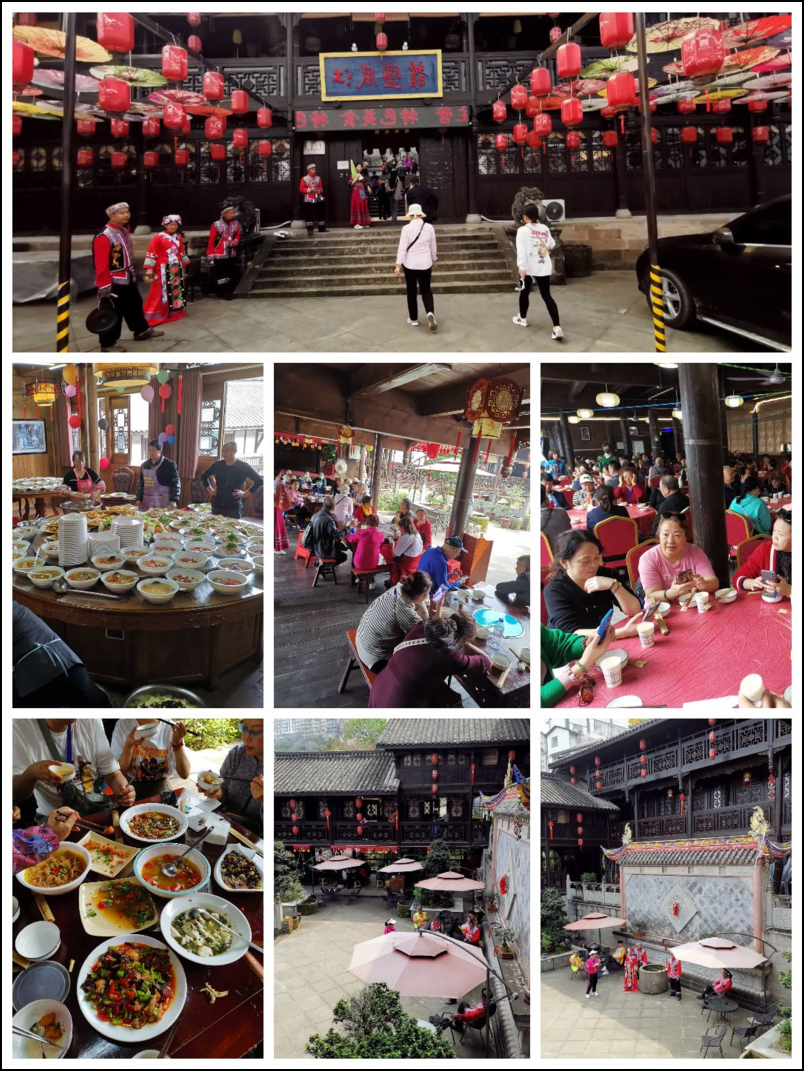
Lunch was held at the "Jiangfeng Yanyun Restaurant" in the town at noon, with 10 people per table, 10 dishes and 1 soup, and rice. The dishes were decent.
During the meal, four Tujia musicians performed live, with one performer simultaneously blowing three suona horns with his mouth and nostrils, winning rounds of applause from everyone.
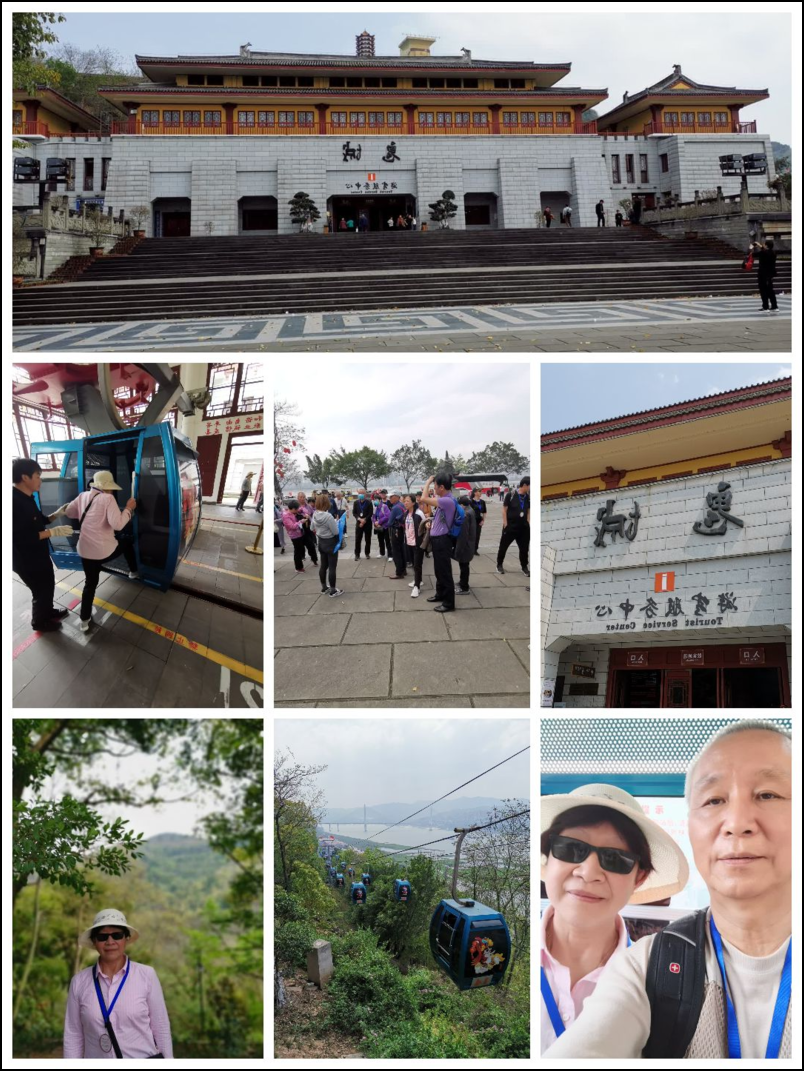
At 1:30, get on the car and drive back to visit Fengdu Ghost City, which is not far from the boat dock.
Fengdu Ghost CityLocated on the north bank of the Yangtze River in Fengdu County, facing Fengdu New County across the river, with an area of 0.45 square kilometers.
There are more than 600 steps from the foot of the mountain to the top of the ghost city. Those who are generally weak can take the cable car back and forth for 35 yuan per person.
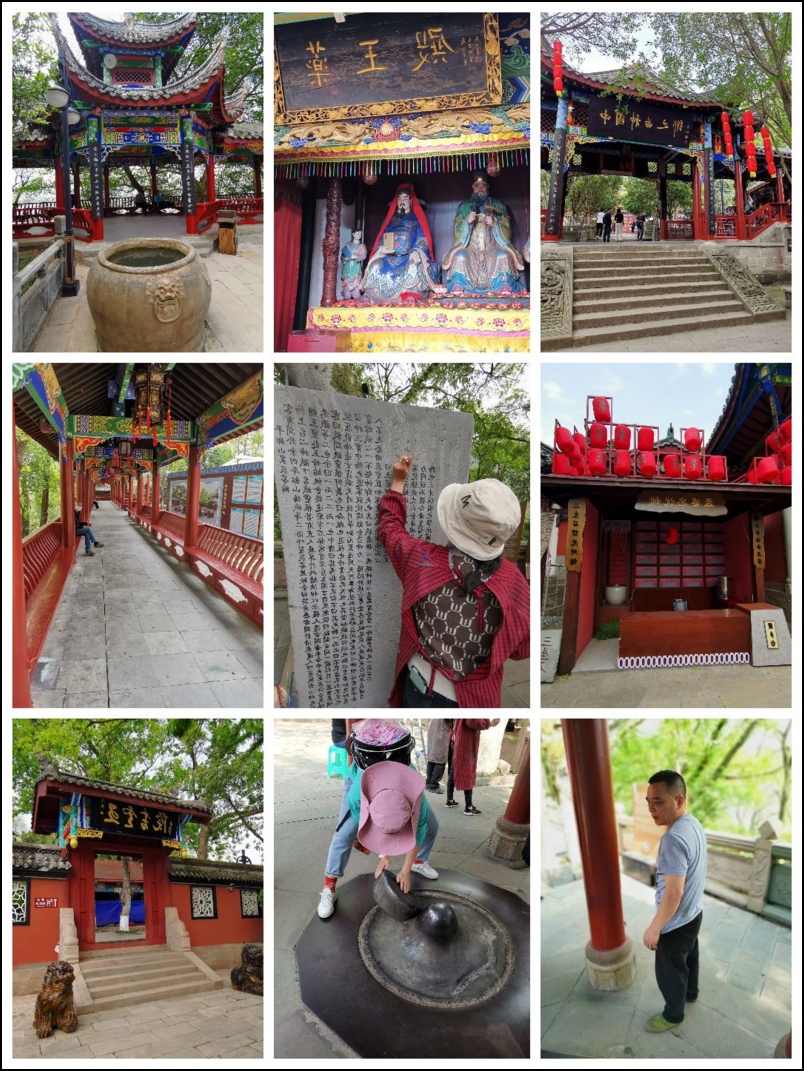 Fengdu Ghost City
Fengdu Ghost CityIt is a historical and cultural city that originated in the Han Dynasty, and is known as the "capital of the ghost country" and the "underworld of Yin Cao", becoming the destination of human souls. Ghost City is also known as "Youdu", "Ghost Country Kyoto", and "Hometown of Chinese Divine Comedy".
Guicheng is famous for its various Yin Cao Di Fu buildings and shapes. There are many buildings in the ghost city that depict the underworld, such as the Heha Temple, Tianzi Hall, Naihe Bridge, Huangquan Road, Wangxiangtai, and Yaowang Hall.
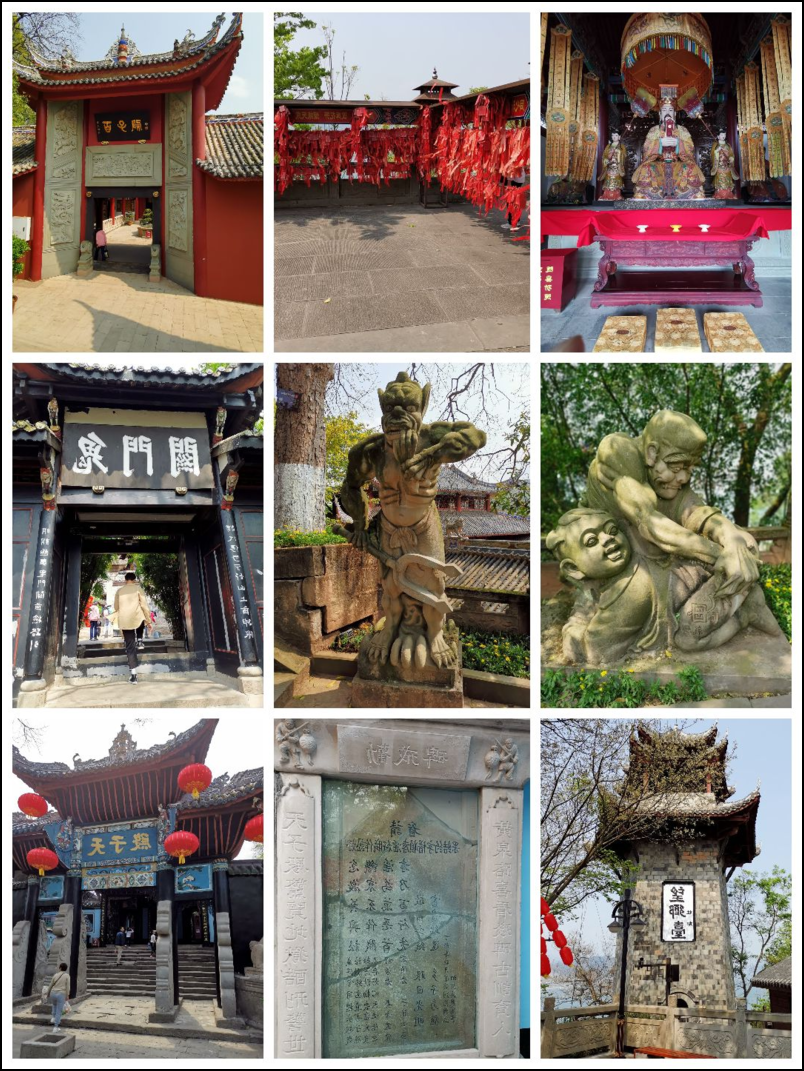
The Hall of Hell and Black and White Impermanence
Yama, also known as the King of Hell, is considered the ruler of hell and is in charge of the cycle of hell. The Hall of Hell originally referred to the place where the King of Hell sits as a council member, but now it is used to refer to the terrifying and dark place where people die.
Black and white impermanence, also known as impermanence. They are a pair of gods in Han folk culture and also the most famous ghost attendant. These two gods hold shackles and handcuffs, specializing in capturing ghosts, assisting in rewarding good and punishing evil, and often serving as subordinates of underworld gods such as Yama, City God, and Dongyue Emperor.
White impermanence is named Xie Bi'an and belongs to Yang. He often wears a smile on his face, is tall and thin, has a pale complexion, and has a long tongue. The official hat on his head is inscribed with the four words "wealth at first sight", giving thanks and good luck to those who respect the gods. He is revered as "impermanent in life", "White Lord", "Seventh Lord", and so on. Absorb the male's yang soul and disperse the female's yin soul.
Black impermanence is called Fan Wujiu and belongs to Yin. The face is fierce, the body is wide and fat, with small black faces. The official hat is written with the words "peace under heaven", meaning that there will be no pardon for those who violate the law and commit crimes. They are revered as "Dwarf Lord", "Black Lord", and "Eight Lord". Absorb the female soul and disperse the male soul.
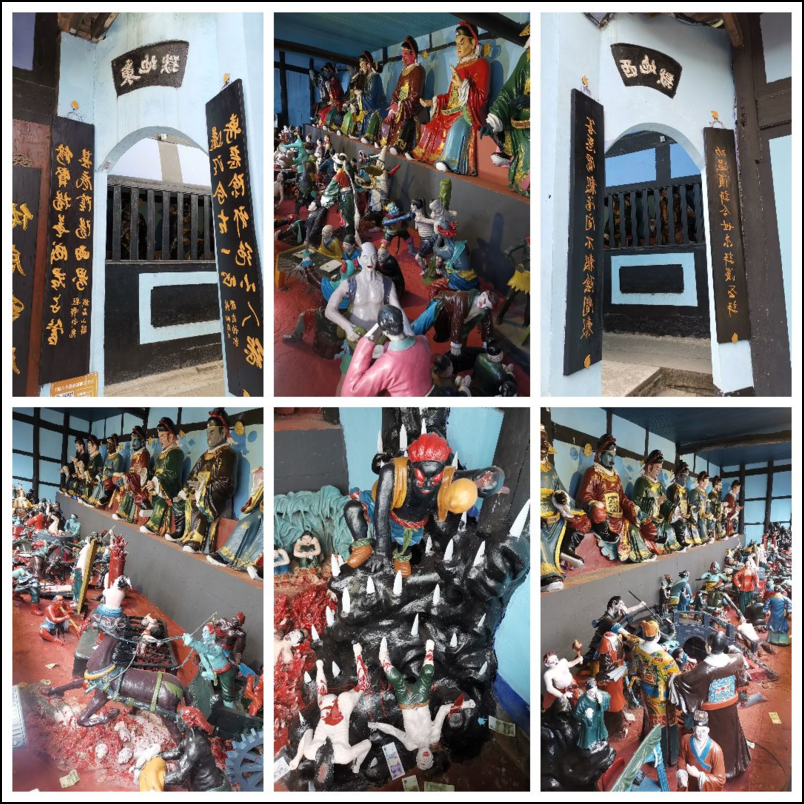 The most famous eighteen levels of hell
The most famous eighteen levels of hellThe origin of the eighteen levels of hell can be traced back to Buddhist teachings. The "eighteen levels" of hell referred to in Buddhism do not refer to the layers of hell up to the eighteenth level. Hell is not divided into levels, but is described according to time, degree of suffering, and size of the area. It is just a misunderstanding by people. The eternal hell that never transcends is collectively called the Infernal Hell, which means suffering without interruption, not resting for a second, and suffering for eternal life.
The common names for the eighteen levels of hell in folk culture are: Tongue Pulling Hell, Scissors Hell, Iron Tree Hell, Lotus Mirror Hell, Steaming Cage Hell, Copper Pillar Hell, Knife Mountain Hell, Iceberg Hell, Oil Pot Hell, Bull Pit Hell, Stone Pressure Hell, Spring White Hell, Blood Pool Hell, Wrongful Death Hell, Plate Punishment Hell, Volcanic Hell, Stone Grinding Hell, and Knife Saw Hell.
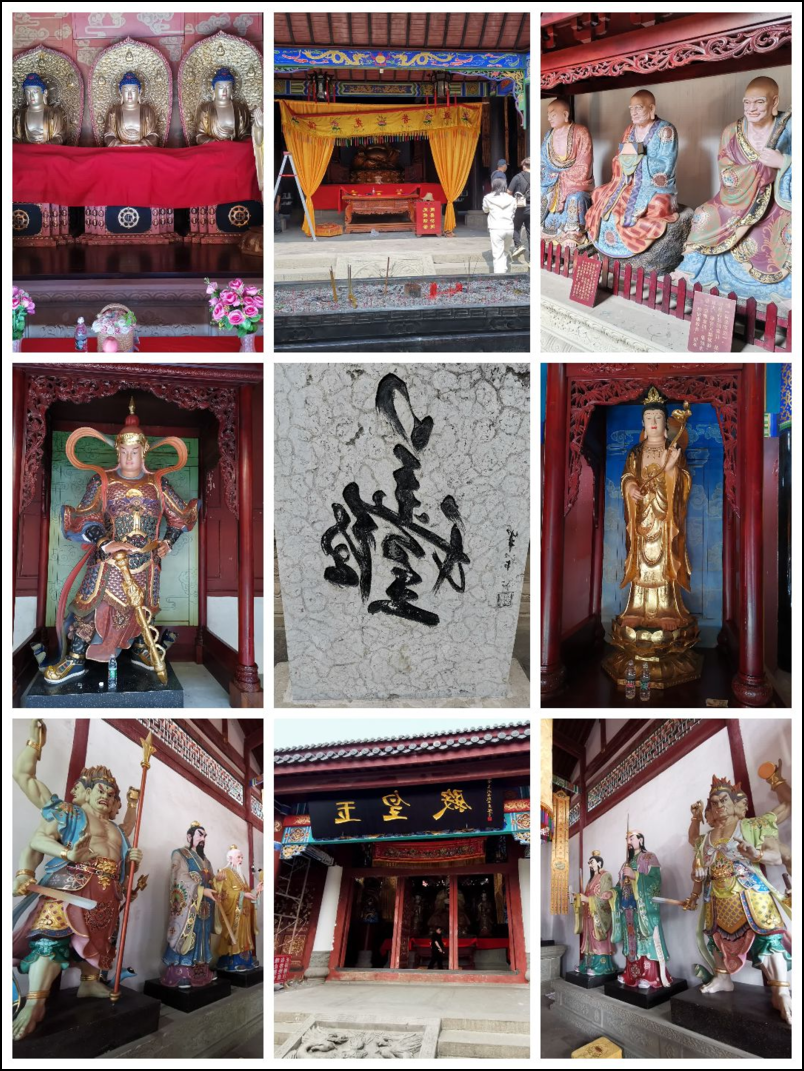
The "Ghost City" has gone through more than two thousand years of history from fantasy to reality, organically combining Buddhism, Taoism, Confucianism, and Chinese ghost culture; Integrating Ba Yu culture, Central Plains culture, and foreign cultures; Combining the imagination of folk myths and legends with reality; The combination of various art forms such as architecture, sculpture, and painting has formed the famous "ghost city culture" today.
It is not only a legendary ghost city, but also a treasure trove of folk culture and art that integrates Confucianism, Taoism, and Buddhism.
In December 2015, Guicheng Mingshan Scenic Area was selected as one of the 30 best new tourist attractions in the Three Gorges of the Yangtze River.
At 3:30 pm, return to President 6 and hand over the departure card to the staff.
At 4:30, the cruise ship departs from Fengdu Port and heads towards Baidi City.
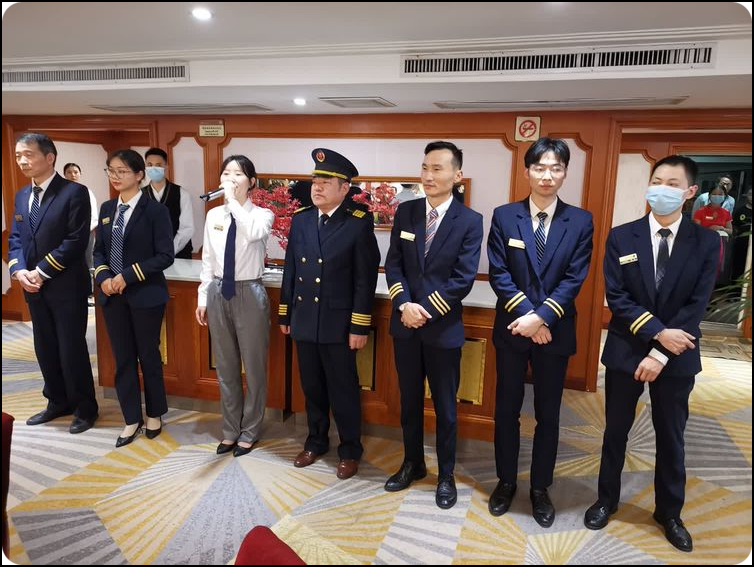
At 6:30, the captain led the team members to meet and deliver speeches at the welcome dinner.
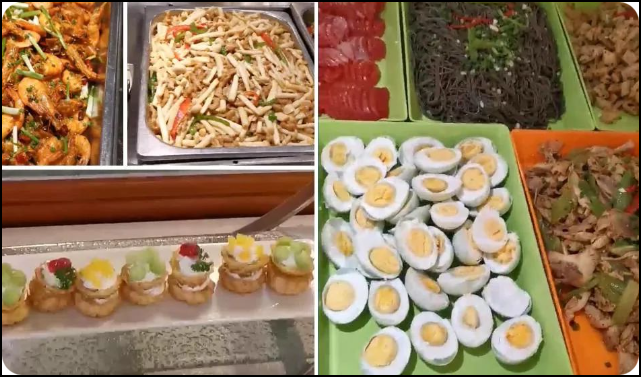
The three meals on the cruise ship are quite sumptuous and the taste is also good.

The third day of the President's Nine Day Tour on the Three Gorges Cruise
Last night, the voyage continued, covering a distance of 275 kilometers from Fengdu Port to Fengjie Port.
At night, thunder and lightning flashed, and heavy rain poured down.
I went ashore for a visit this morning
White God City;
Noon boat
Passing through Kuimen, Qutangxia, and Wuxia;
Change to a small boat tour in the afternoon
Shennong Creek.
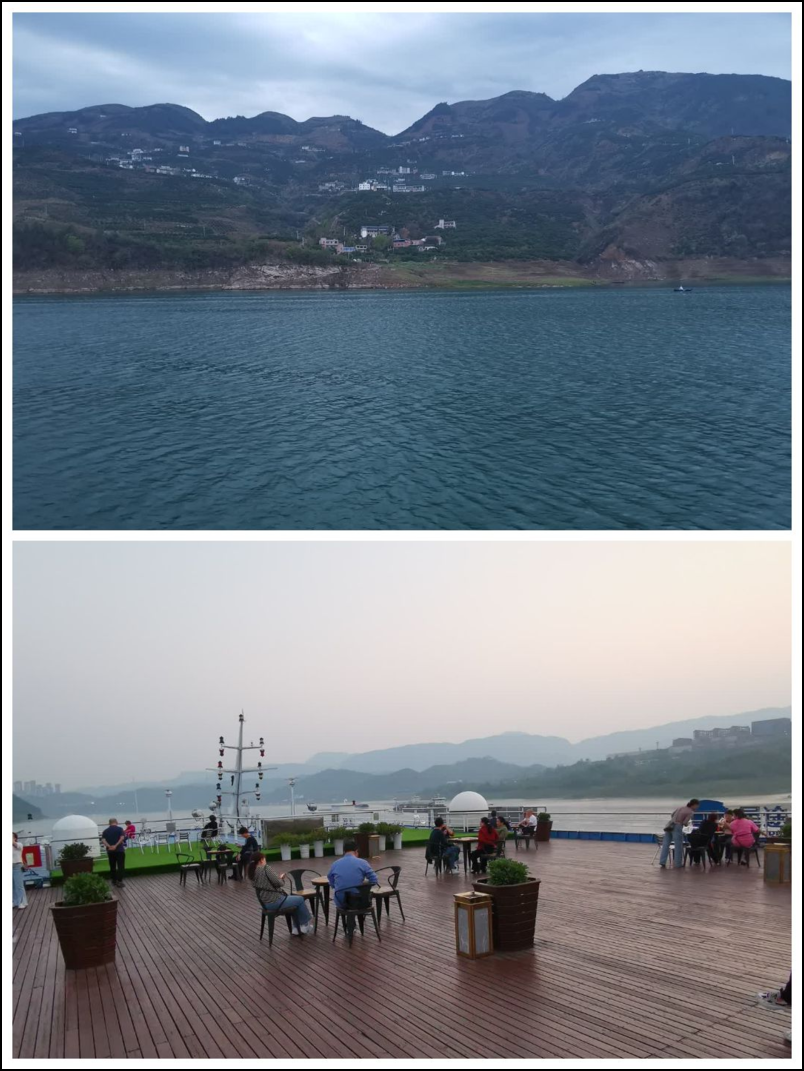
The first picture taken early in the morning.
The section of the Yangtze River within Sichuan Province is well protected, with green and blue water, clear water quality, almost no floating objects on the surface, and no dead fish seen.
To this end, we give our thumbs up and pay tribute to the local governments and people along the Sichuan River!
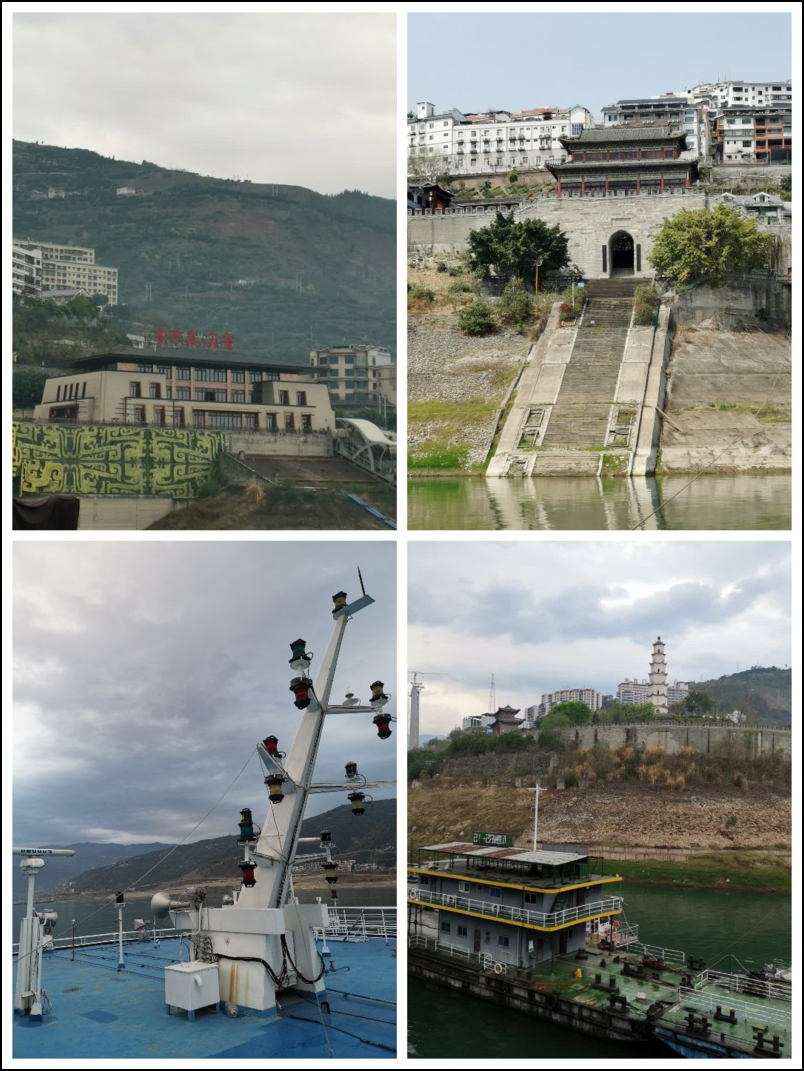
The ship docks at Fengjie Port.
Fengjie CountyBelonging to Chongqing City, it is the eastern gateway of Chongqing City, located in the heart of the Three Gorges Reservoir Area of the Yangtze River. It borders Wushan County to the east, Enshi City in Hubei Province to the south, Yunyang County to the west, and Wuxi County to the north. Fengjie County has a permanent population of 747300.
Fengjie was later known as Yufu, Yong'an, and Renfu. In the 23rd year of the Zhenguan reign of the Tang Dynasty (649 AD), Emperor Taizong of Tang, Li Shimin, in order to honor the character of Zhuge Liang and Liu Bei, who entrusted him with the task of serving as an orphan and not being able to be taken away, changed his name back to Fengjie.
Fengjie specialties include navel oranges, kui pomelos, pickled vegetables, white tobacco, sun dried dates, cured meat, tribute tea, etc.
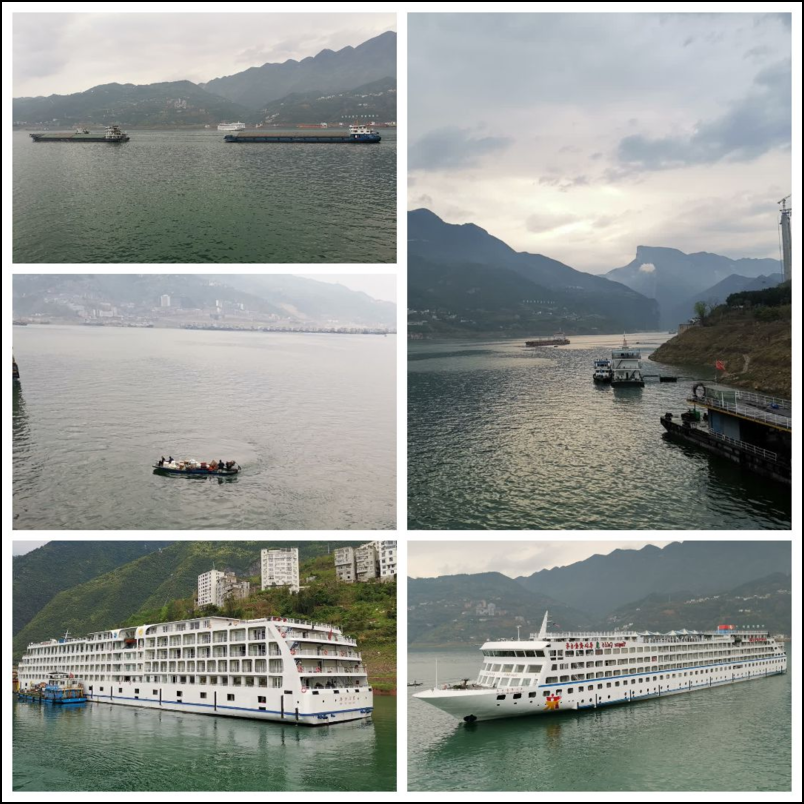
The Golden 6 cruise ship closely followed my ship and docked outside at 7:50.
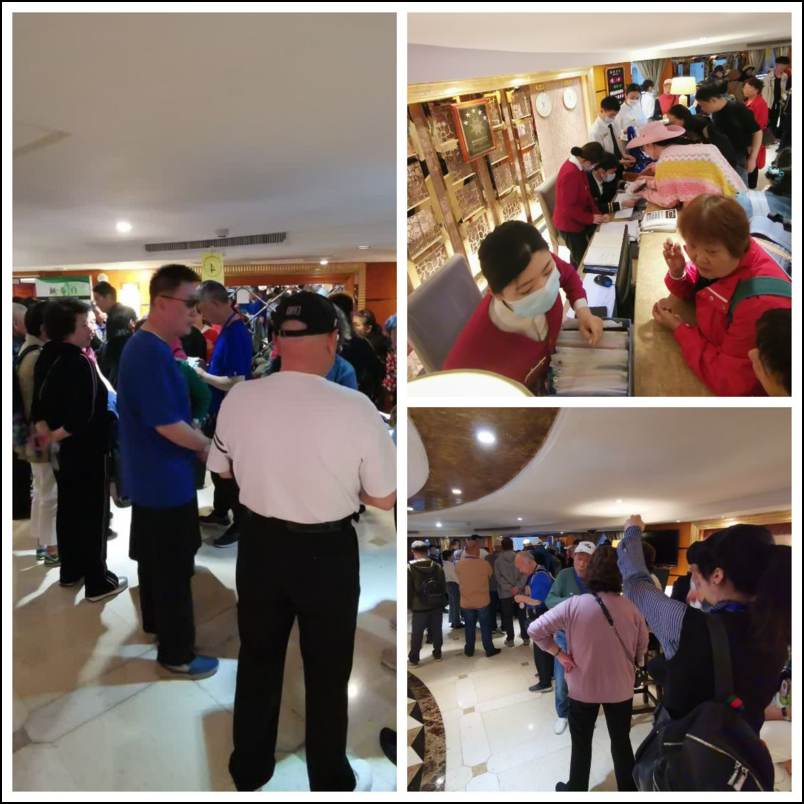
Tourists waiting to disembark
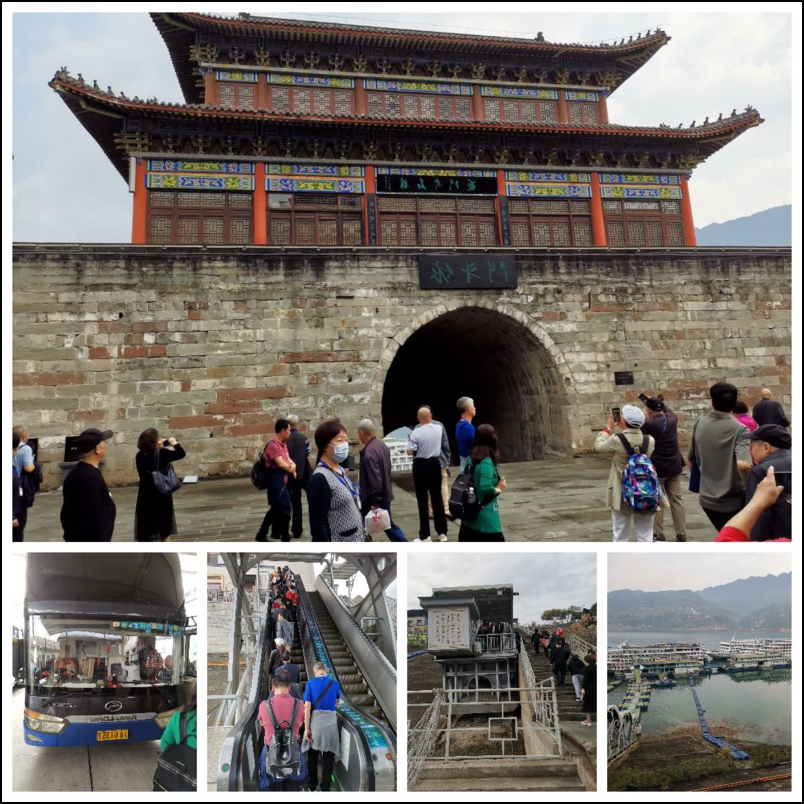 Baidicheng Pier
Baidicheng PierAlso known as Zhongyi Ferry.
The dock has good conditions and is equipped with automatic rolling stairs, making it convenient for tourists to disembark.
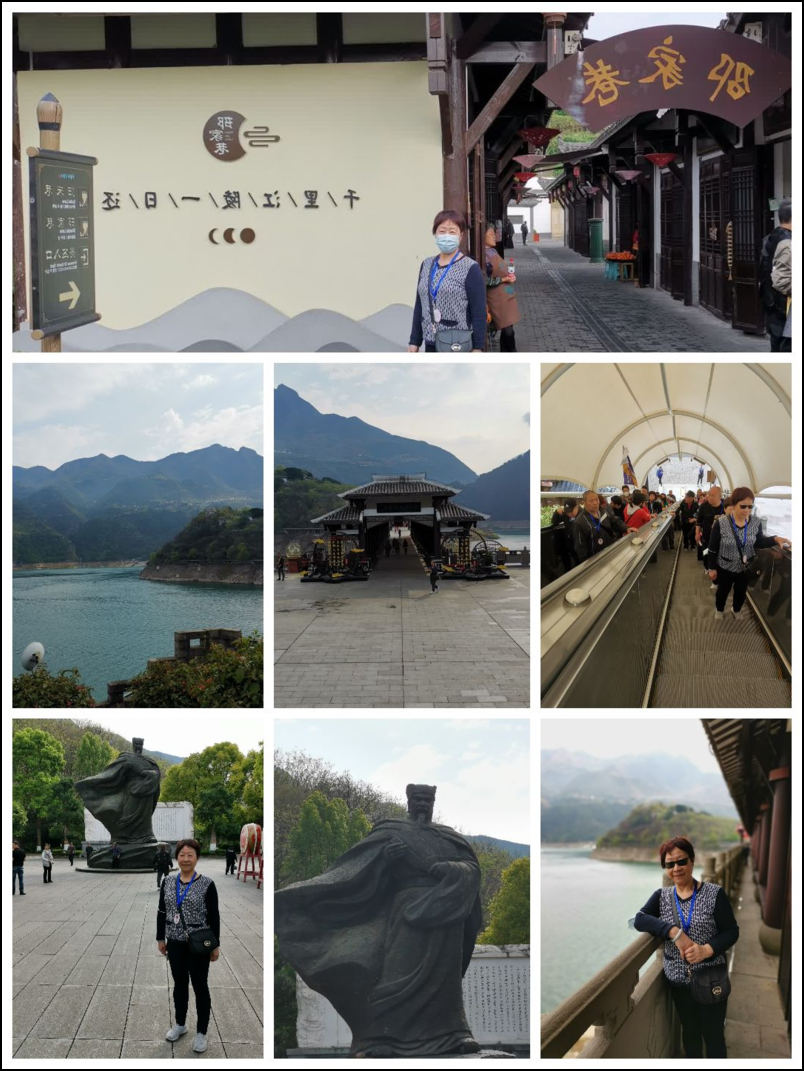
Exit the White Emperor City Pier and enter
Zhongyi SquareThis newly constructed square covers an area of approximately 7000 square meters, nestled among numerous precious tree species such as osmanthus, camphor, and ginkgo, exuding a quaint yet grand atmosphere.
The statue of Zhuge Liang, with a total height of 7.9 meters and a portrait height of 5 meters, is made of bronze and stands tall in the wind on a huge rock at the entrance of Zhongyi Square. To the left is the rolling Yangtze River, to the right is the "Memorial to the Departing Army" inscription, and behind it is the majestic Kuimen Gorge.
Zhuge Liang StatueWith fluttering clothes and a calm demeanor, Zhuge Liang's spirit is prominently displayed, showing his loyalty, steadfastness, composure, wisdom, dedication, and determination in times of danger.
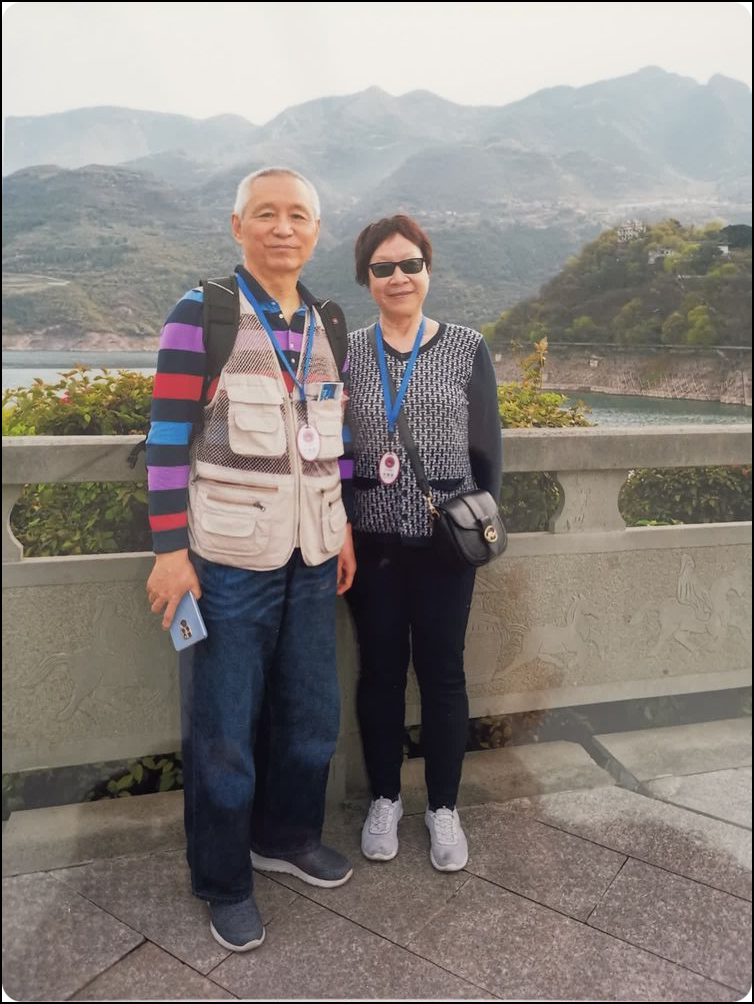
After leaving the dock and Zhongyi Square, it takes more than ten minutes by bus to reach Baidi City.
White God CityOriginally connected to the north bank, at the confluence of the Yangtze River and Caotang River.
After the Three Gorges Dam was filled with water, Baidi City became an isolated island in the river, now connected to the shore by a wind and rain covered bridge. The Caotang River also flows into Kuimen from the vicinity of Baidi City.

The mountain is steep with many steps, and the business of sliding poles is booming.
The average price for both directions is 120 yuan per person, and for those who are light or heavy, the price fluctuates based on this.
There is an elderly couple, a man in his 90s (holding a cane) and a woman in her 80s (wearing a red shirt), who originally wanted to climb the mountain with us. We advised them to prioritize their lives over their wealth. The two elders listened to our advice and happily sat on the slide.
 White God City
White God CityLocated to the east of Kuimen and surrounded by water on three sides, it is a strategic location that has been contested by military strategists throughout history.
In the late Western Han Dynasty, Gongsun Shu occupied Shu and built a city on a mountain. Because a well in the city often emitted white gas, resembling a white dragon, he used this to call himself the White Emperor and named this city the White Emperor City.
In the year 222 AD, Liu Bei's eastern expedition against Wu was unsuccessful, resulting in the defeat of Yiling and his retreat to Baidi City. The following year, he passed away due to illness here.
Before Liu Bei's death, he urgently summoned important officials such as Zhuge Liang from Chengdu to Baidi City, where he passed on the throne to Liu Shan and entrusted Zhuge Liang with his care. This is the famous' Yong'an Tuogu 'in history.
From then on, the history of the Liu Bei Group and the Shu Han regime was divided into two parts, with Liu Bei as the early leader and Zhuge Liang as the later backbone.
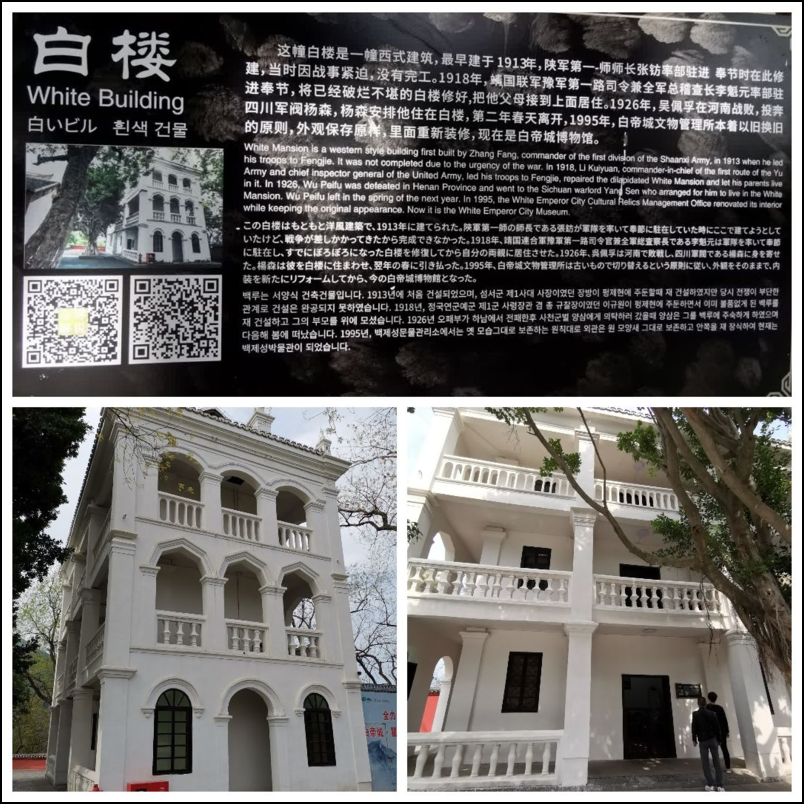 The White Tower in the Baidicheng Scenic Area
The White Tower in the Baidicheng Scenic AreaThis building is a typical European style architecture, first built in 1913 when Zhang Fang, the commander of the Shaanxi Army's First Division, entered Fengjie. Due to the urgency of the war, it was not completed.
In 1918, Li Kuiyuan, the commander of the first route of the Henan Army of the Jingguo United Army and the chief inspector of the entire army, led his troops to enter Fengjie and repaired this building as a place for leisure and cooling off. In 1926, Wu Peifu lived here after the defeat in Henan.
The entire building, whether in terms of overall design or detailed treatment, has strong artistic qualities and is also very harmonious with the surrounding environment, achieving an organic combination of architecture and environment.
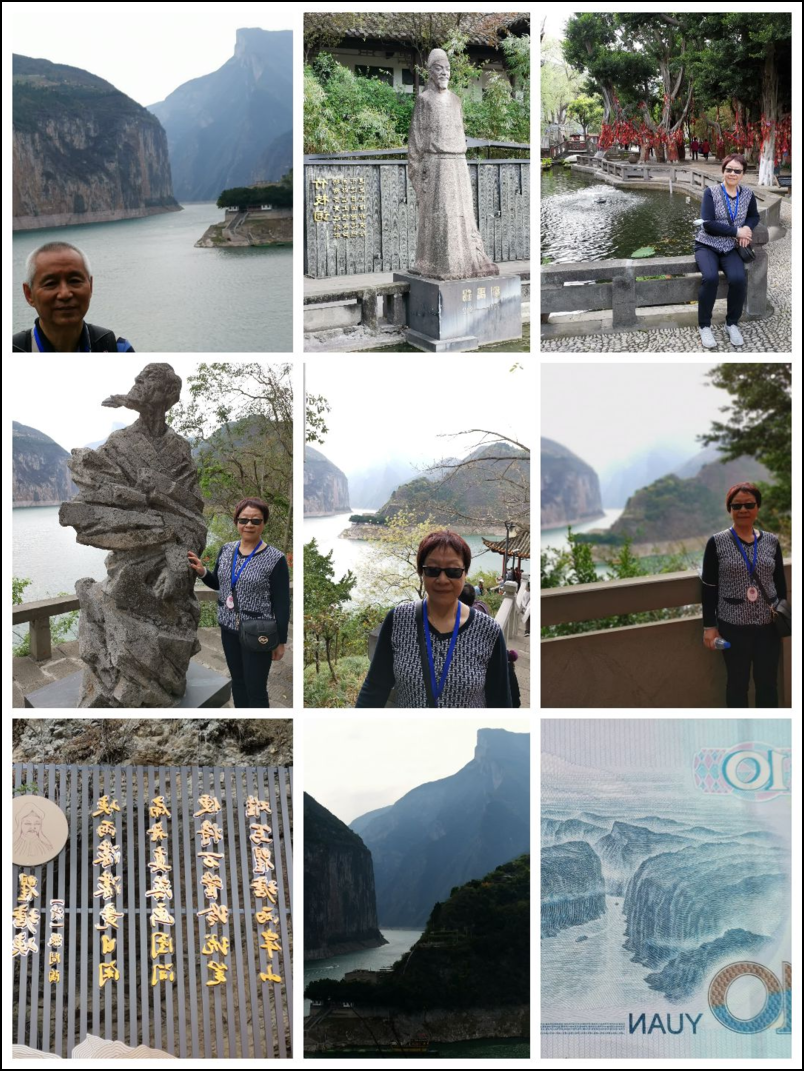
Landscape on the south side of Baidi City and Yuantiao Kuimen.
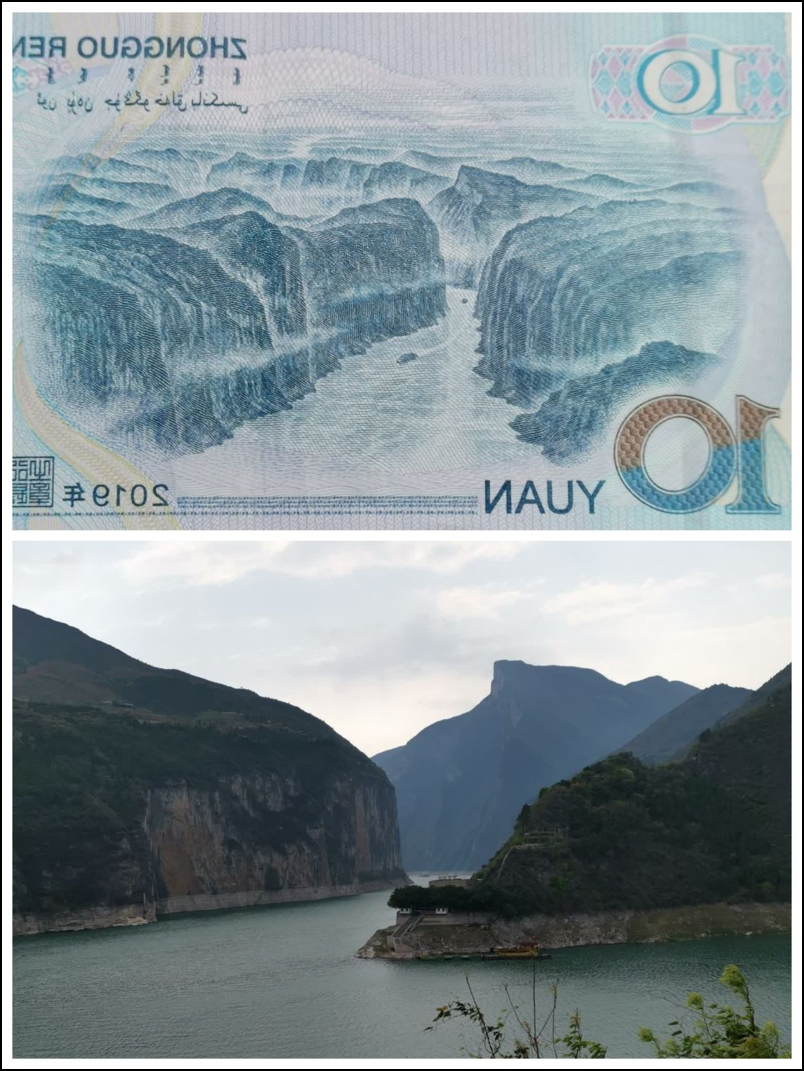
The pattern on the back of the ten yuan Renminbi and the view of Kuimen from Baidi City.
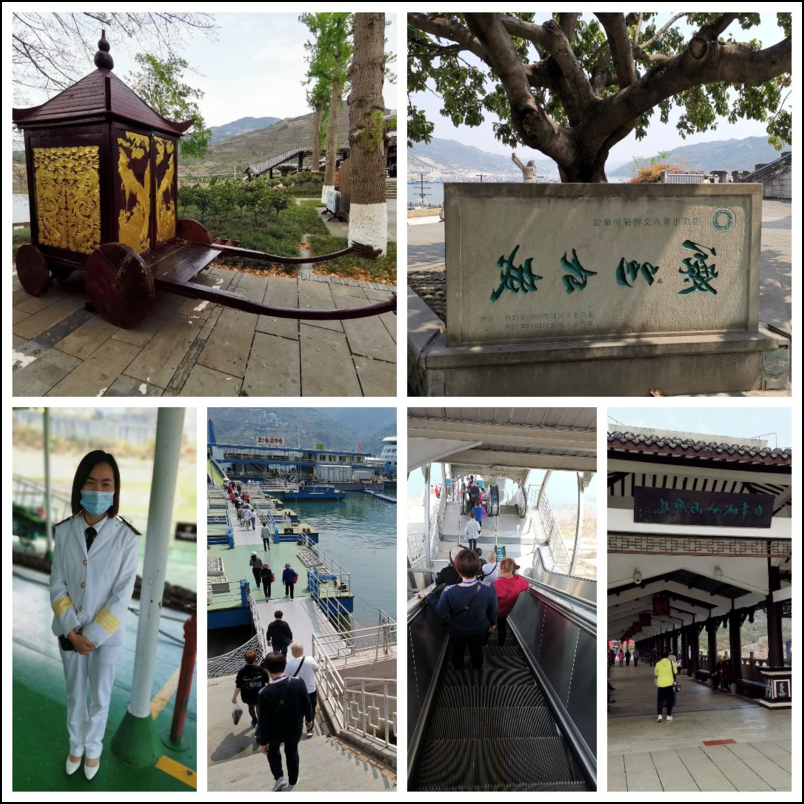
After visiting the Baidicheng Scenic Area, return to the cruise ship.
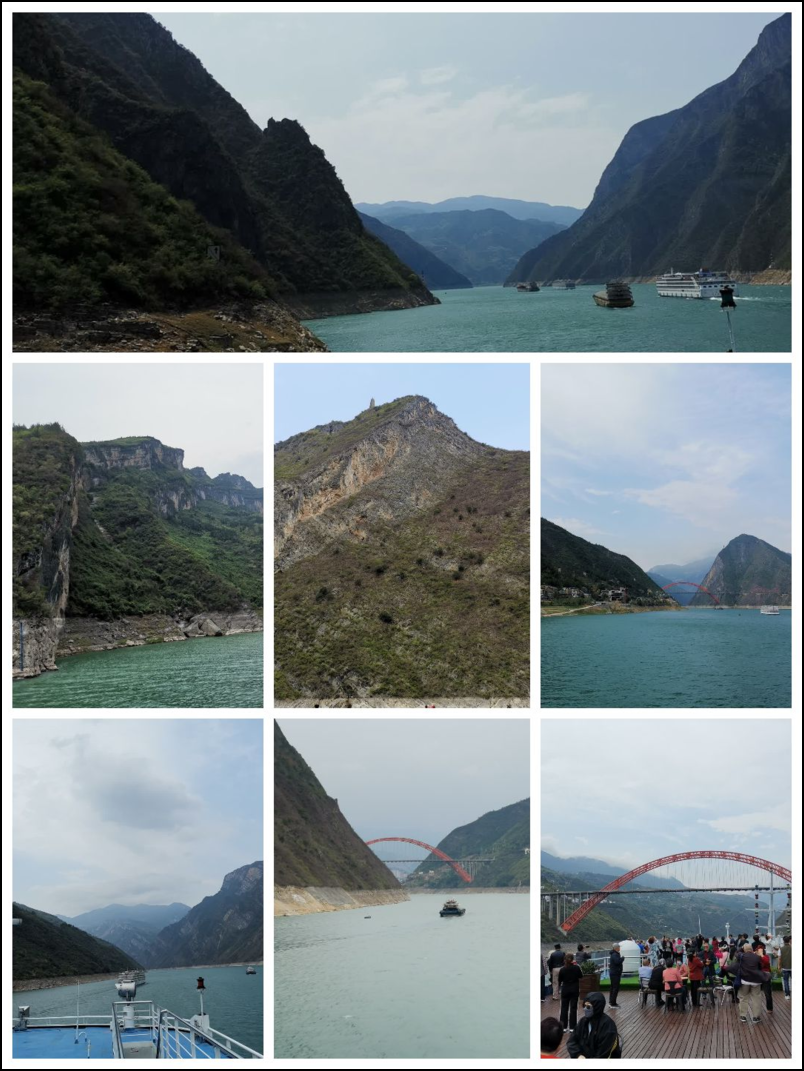
Passing through Kuimen and Qutang Gorge.
Kuimen, also known as Qutangguan, is located at the foot of Kuimen Mountain in Qutangxia, Fengjie County. It was an important pass on the ancient eastward route to Shu and has been a battleground for military strategists since the Qin and Han dynasties. The high mountains and steep rivers on both sides of the Yangtze River are the gateway for the Yangtze River to enter the Three Gorges from the Sichuan Basin. Due to the turbulent and roaring waters, it is known as the "Mighty Master of Kuimen" that makes people feel uneasy.
Qutang Gorge, about eight kilometers long, is one of the Three Gorges of the Yangtze River. The cliffs on both sides stand tall, the river is raging, and the gorge is surrounded by piles of rocks, standing in the heart of the river. The situation is dangerous, serving as the gateway to the entire Shu River Road.
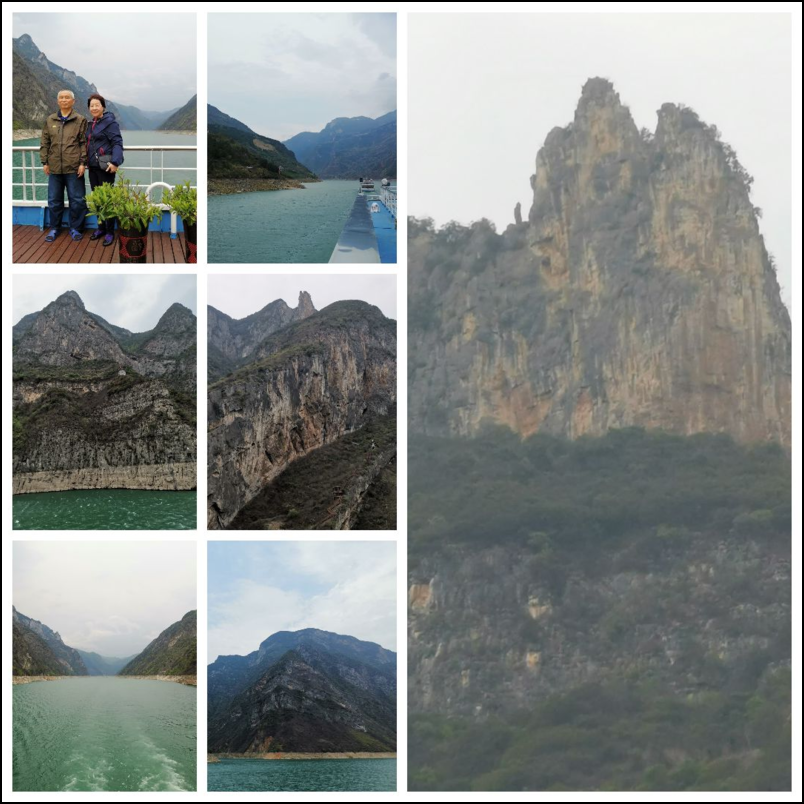
Crossing the Wu Gorge, I saw the "fairy" on the Fairy Peak.
Wuxia is 46 kilometers long and is known as the Great Canyon.
Wuxia is beautiful and deep, renowned throughout the world for its handsomeness. The gorge is long and deep, with abrupt peaks and layers of rolling hills. Clouds rise and fog swirl around, and the river flows in twists and turns. As boats navigate through it, it feels like entering a magnificent gallery, full of poetic and picturesque charm.
The majestic peaks lead to a river, and the majestic key of Jingxiang is a true portrayal of it. On both sides of the Xiajiang River, there are endless green mountains and peaks like screens. When boats sail through the gorge, sometimes the mountains are in front of them, and the stone barriers seem impassable; Suddenly, the road turned again, and the clouds parted into a different sky, like a winding gallery.
At 4 pm, the cruise ship docked at Shennongxi Pier in Badong County, Hubei Province, and transferred to a double decker small cruise ship to visit Shennongxi Scenic Area.
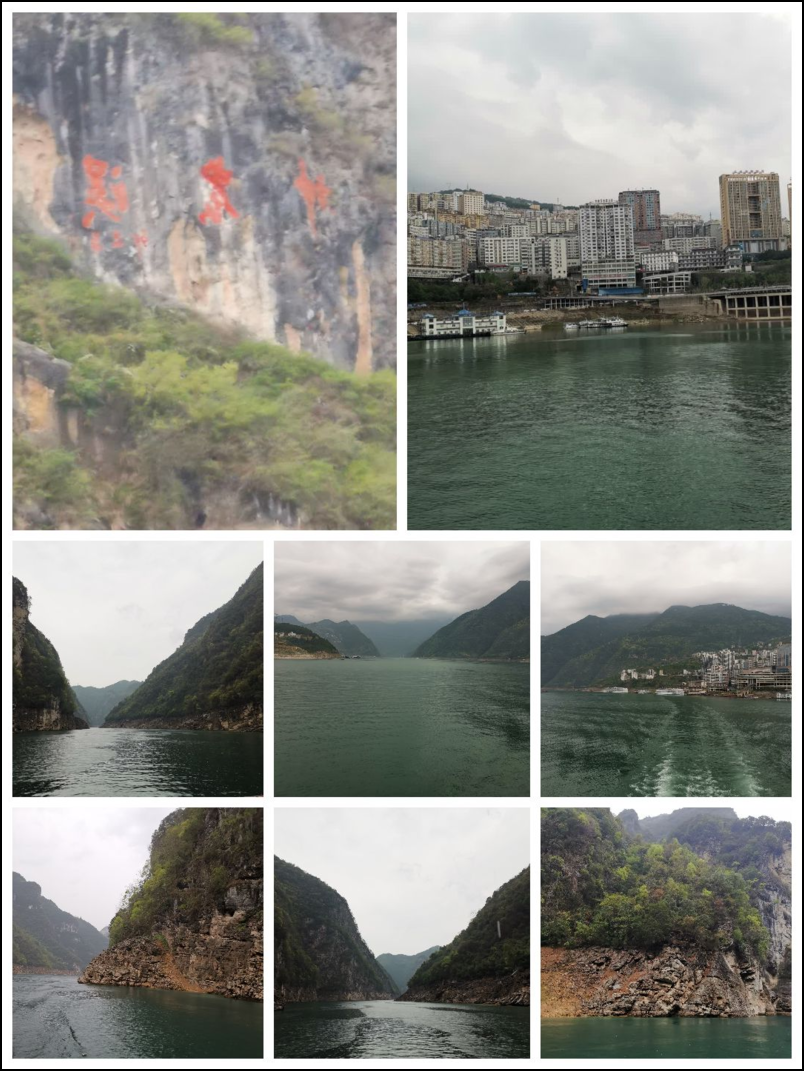 Shennong Creek
Shennong CreekThe tourist area is a perennial stream on the north bank of the Yangtze River in Badong County, Hubei Province. It originates from the southern slope of Shennongjia, known as the "first peak in Central China", and runs through deep mountain canyons from south to north. It joins the Yangtze River 2000 meters east of the mouth of Wuxia, with a total length of 60 kilometers.
On both sides of the stream, the mountains stand tall, winding and stretching, with layers of peaks and ridges, forming three dangerous, beautiful, and unique natural gorge sections: Longchang Gorge, Yingwu Gorge, and Shennong Gorge.
The deep pools, clear waters, waterfalls, hanging coffin paths, primitive flat boats, Tujia customs, and stalagmite caves in the gorge are all breathtaking.
It has been raining outside, so tourists can only sit inside the boat and enjoy the view through the window in a proper manner.
Tujia tour guides vividly introduce local customs and specialties, while young girls sing Tujia mountain songs. Tourists are given a small cup of tea and small bags of dried cured meat for free. Finally, they vigorously promote "selenium rich" tea (1 bag, 2 boxes, 100 yuan) and "local pig" dried cured meat (1 bag, 100 yuan).
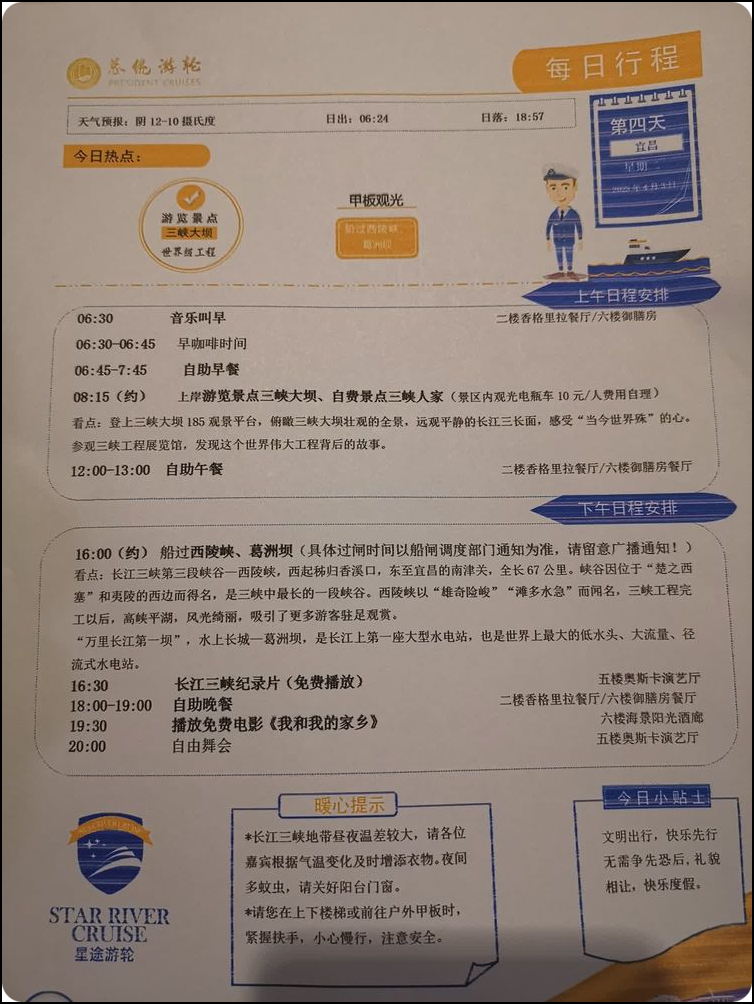
The the fourth day day of the nine day tour of the President of the Three Gorges Cruise Line 6
126 kilometers from Fengjie Port - Shennongxi Wharf - to Yichang Sandaoping Wharf.
This morning we visited the Three Gorges Project, and at noon we visited the Three Gorges Family Scenic Area.
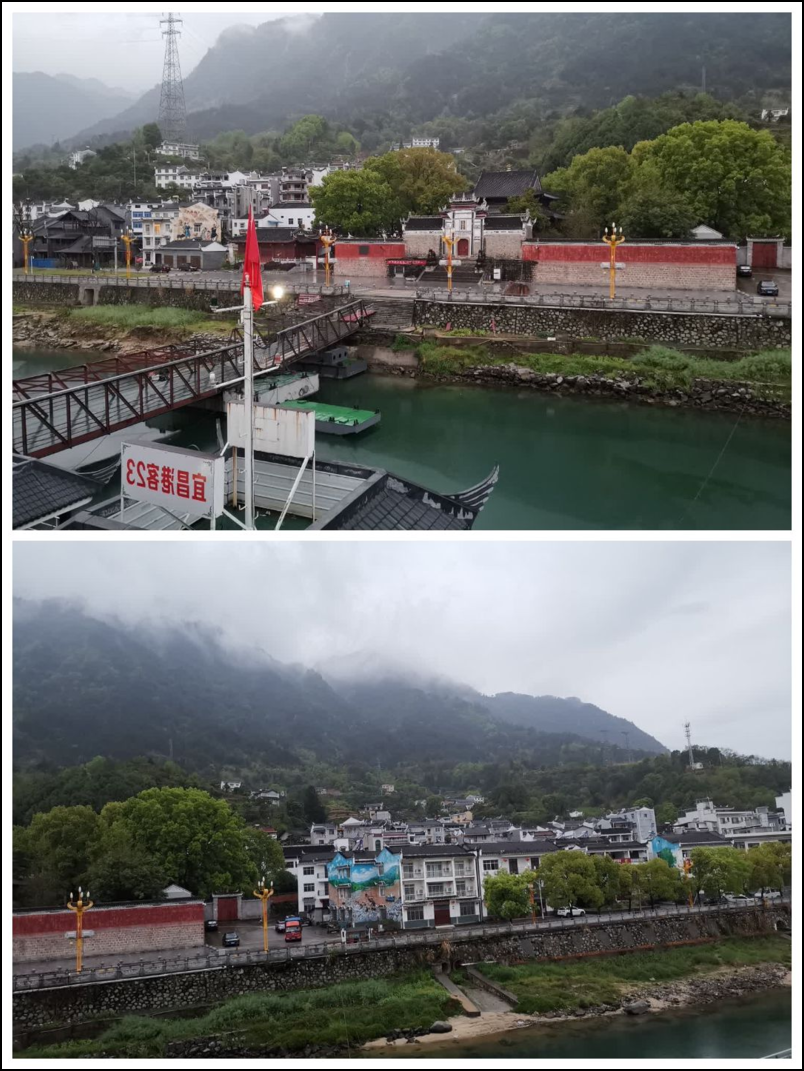
The ship is docked at Sandaoping Pier in Yichang Port.
Sandaoping Town is located in the southwest of Yiling District, Yichang City, on the south bank of the scenic middle section of Xiling Gorge on the Yangtze River. It is adjacent to Qiaobian Town in Dianjun District to the east, Maoping Town in Zigui County to the west, Tucheng Township in Dianjun District to the south, and faces the Three Gorges Project Command and Letianxi Town across the river to the north. Sandaoping Town is the location of the world-renowned Three Gorges Dam site and is known as the "first town at the head of the Three Gorges Dam".
The land in Sandaoping Town is fertile, and the main crops include corn, wheat, rice, potatoes, sweet potatoes, etc. The economic crops mainly include citrus, tea, silkworms, etc. The whole town has formed a development pattern of "10000 acres of citrus at the foot of the mountain, tens of thousands of acres of mulberry on the mountain, famous tea on the mountainside, and rural fruits, medicines, and vegetables".
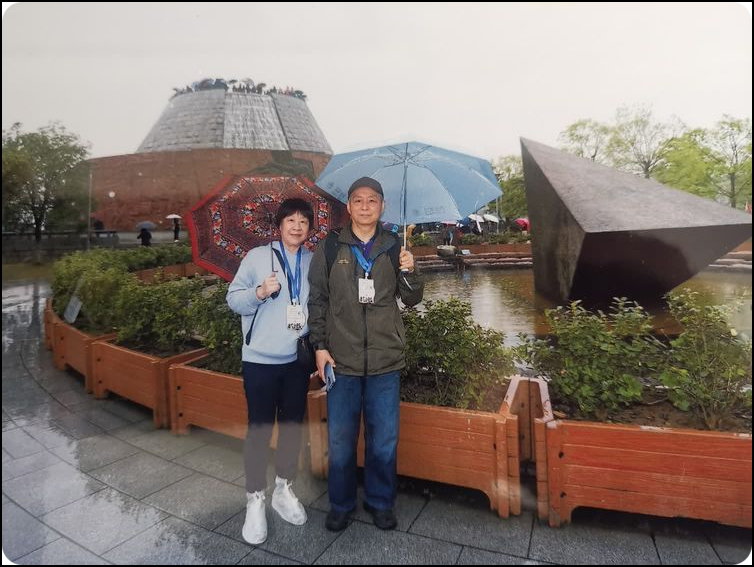
The tourists who disembarked at 7:30 in Yichang took their luggage on a tour of the Three Gorges Project before leaving the ship. After these tourists left, the number of people on board immediately decreased by two-thirds, leaving only tourists to Wuhan and Nanjing.
At eight o'clock, tourists arriving in Nanjing disembark and take a bus for about ten minutes to reach the Three Gorges Project scenic area. At 8:40, pass the security check, drive for about ten minutes, and arrive at Jarling. Take a four step rolling ladder to the top of the mountain, overlooking the dam and the ship lock.
During the visit to the Three Gorges Project, it rained continuously, sometimes big and sometimes small, and there was a lot of water accumulation on the ground, causing many people's clothes, shoes, and socks to get wet.
This is a photo taken at the high point of Tanziling.
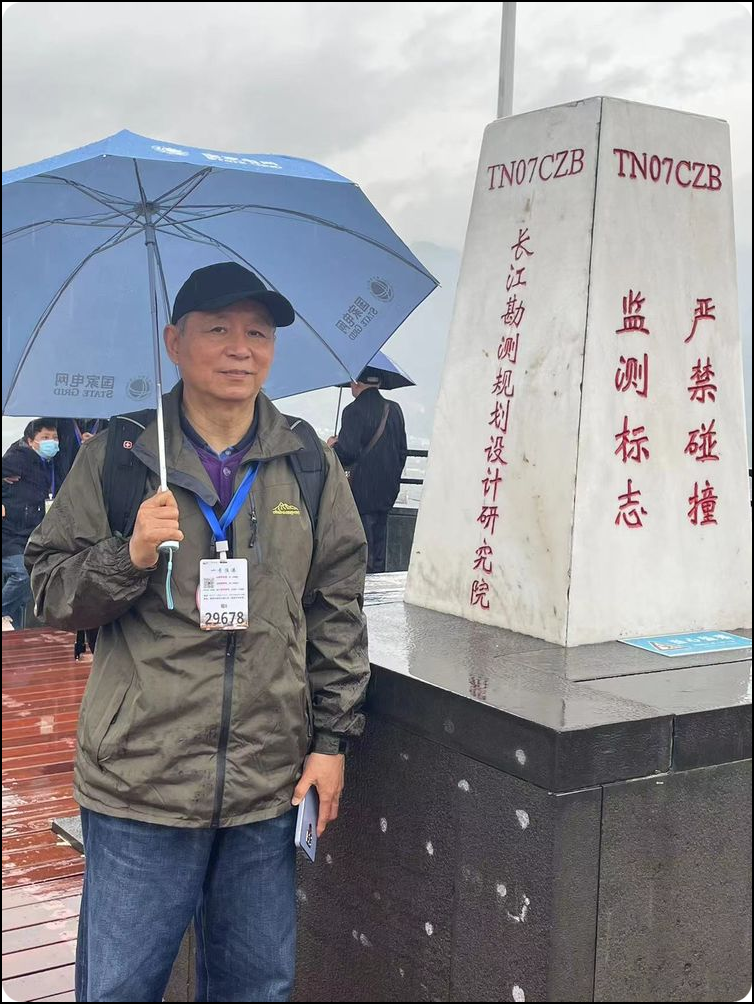
Monitoring markers for the Three Gorges Dam
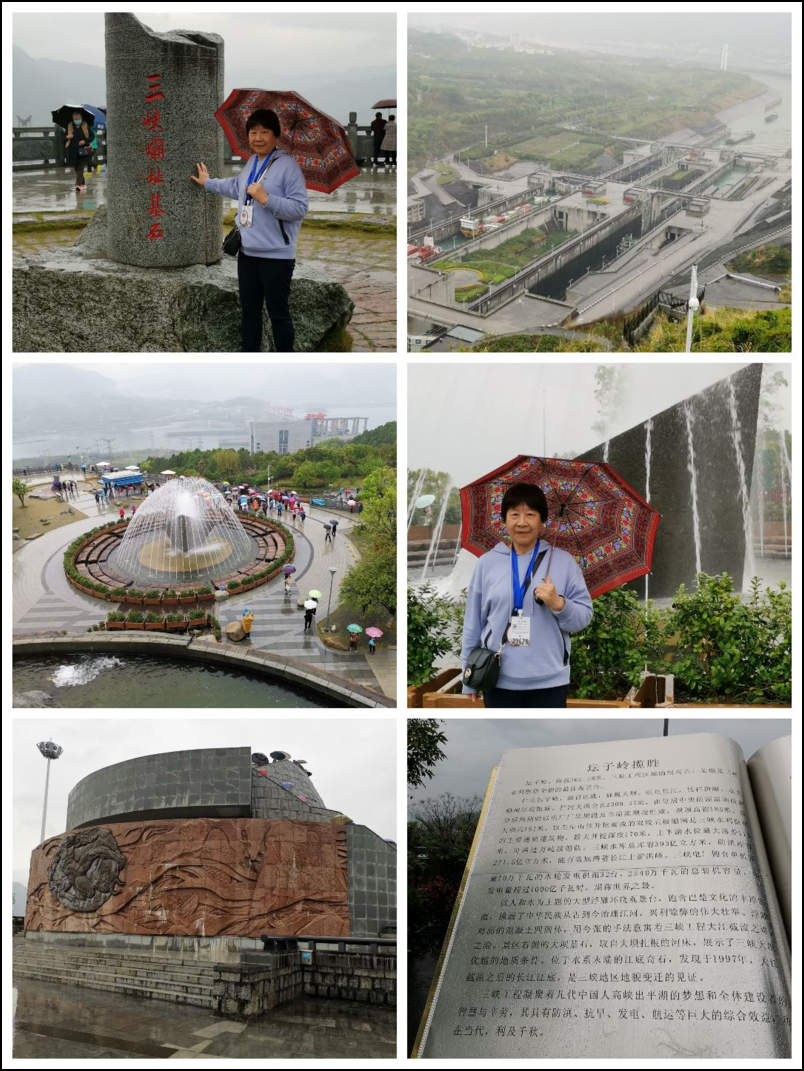
The Three Gorges Dam is the largest hydroelectric power station in the world and also the largest engineering project ever constructed in China. Construction officially began in 1994, and water storage and power generation began on the afternoon of June 1, 2003. The entire project was completed in 2009.
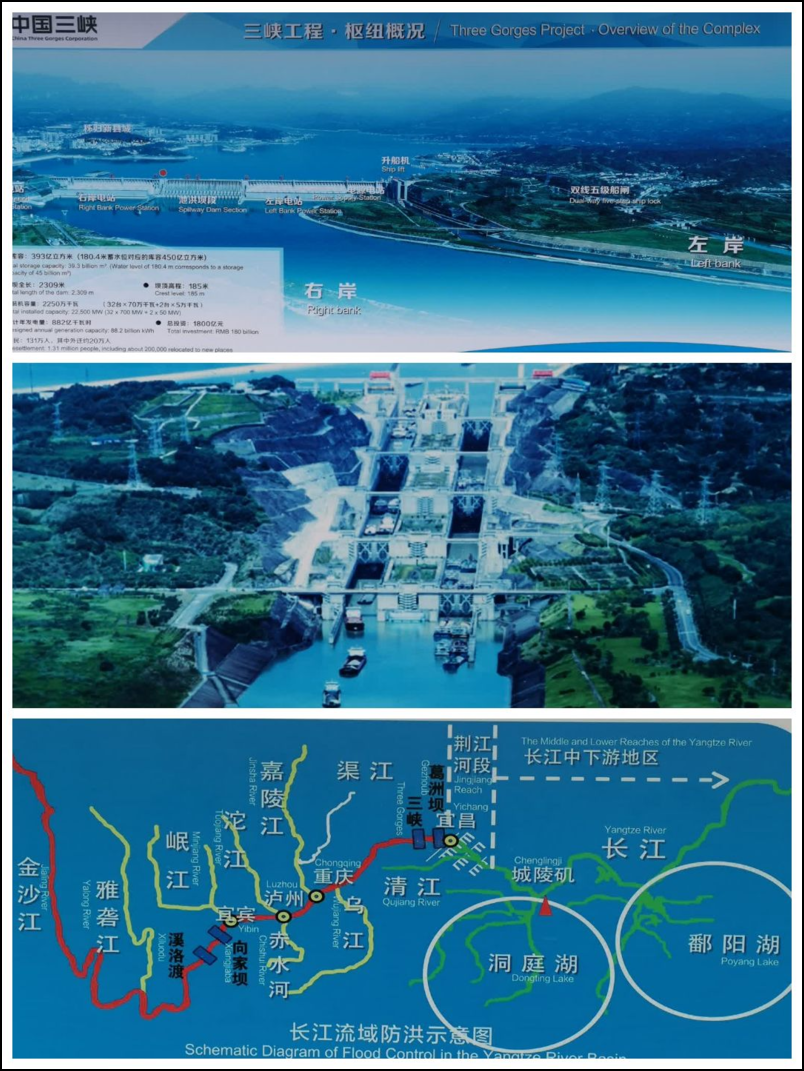
The Three Gorges Dam has an elevation of 185 meters, a storage elevation of 175 meters, a reservoir length of 2335 meters, a static investment of 135.266 billion yuan, and the installation of 32 hydroelectric units with a single capacity of 700000 kilowatts.
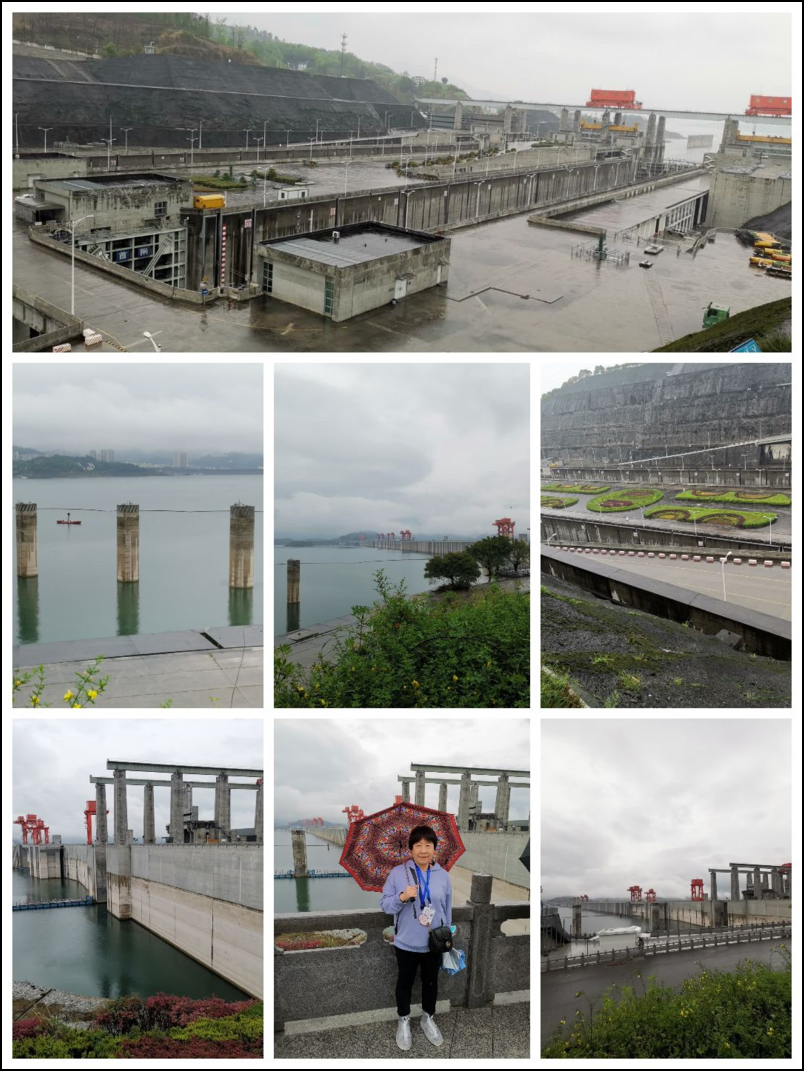
Take an electric scooter for 10 yuan to platform 185, take a close-up view of the ship lock, and leave at 10:20.
I took the tourist bus and drove for 10 minutes to the parking lot to change to the special bus for the Three Gorges People's Scenic Area on the Yangtze River. I drove for more than an hour, and the last section of the road was on the steep cliff road of Xiling Gorge, with dozens of meters of steep walls and rolling river water below. The road was too narrow for two cars to intersect. The bus driver in the scenic area is skilled and bold, and can drive freely.
The car parked at the Yunhua Mountain Villa Restaurant at the intersection of Xiling Gorge and Longjin Creek for lunch, with 10 dishes and 1 soup per table, of average quality.
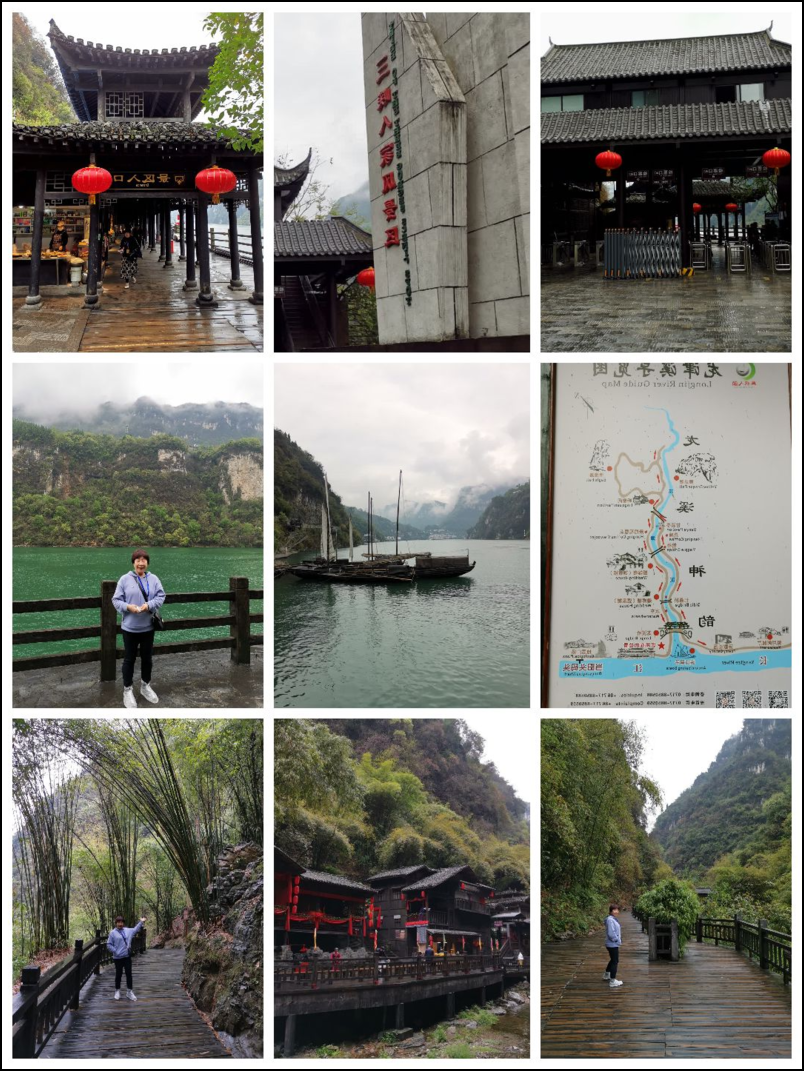
After dinner, board the bus and drive to the parking lot of the scenic area, where tickets will be issued to enter the scenic area.
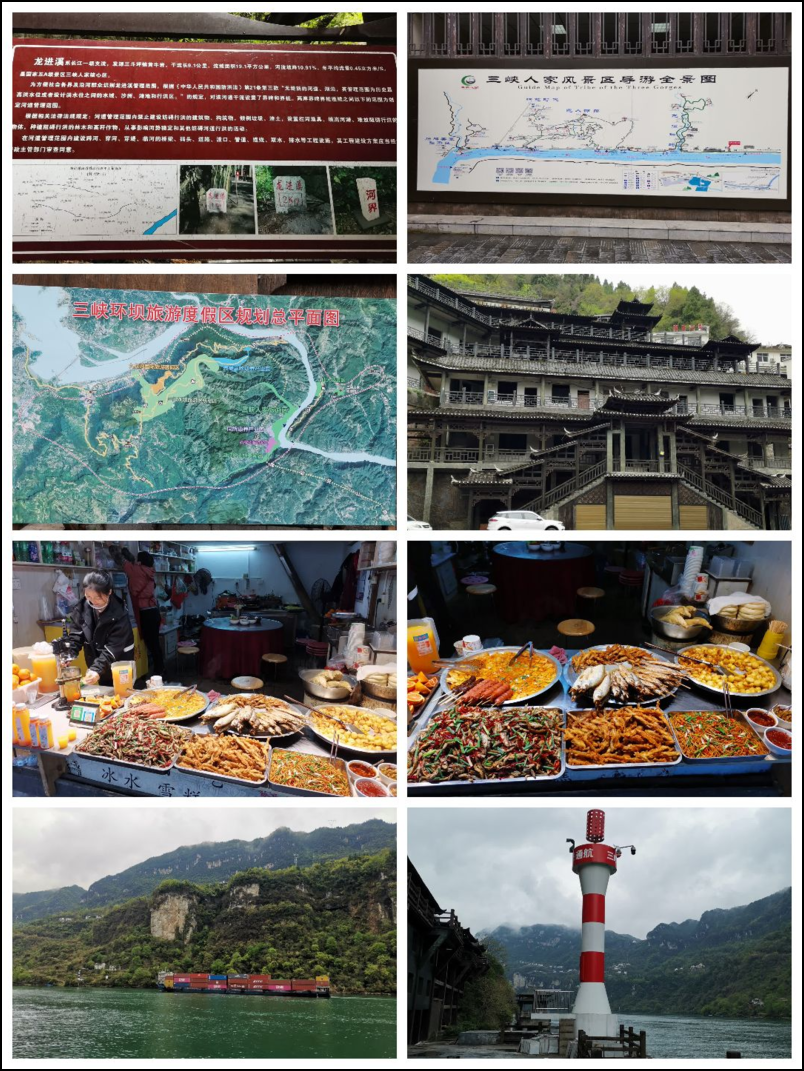
The Three Gorges Family Scenic Area is located in the most fantastic and magnificent Xiling Gorge in the Three Gorges of the Yangtze River, and is a national AAAAA level tourist attraction.
Three Gorges houses are nestled by mountains and waters, with picturesque scenery. Located at Mingyue Bay, a major bend in the Xiling Gorge section between the Three Gorges Dam and Gezhouba Dam, spanning both sides of the beautiful Dengying Gorge, with an area of 14 square kilometers.
Xiling Gorge photo shoot
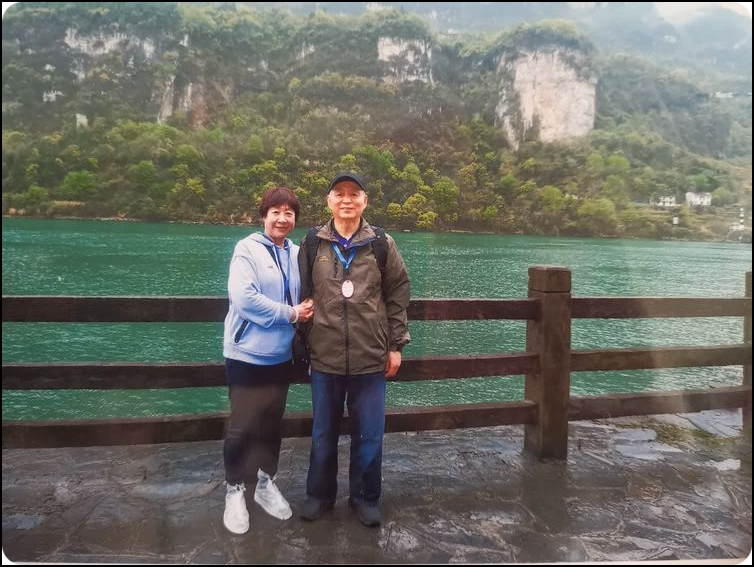
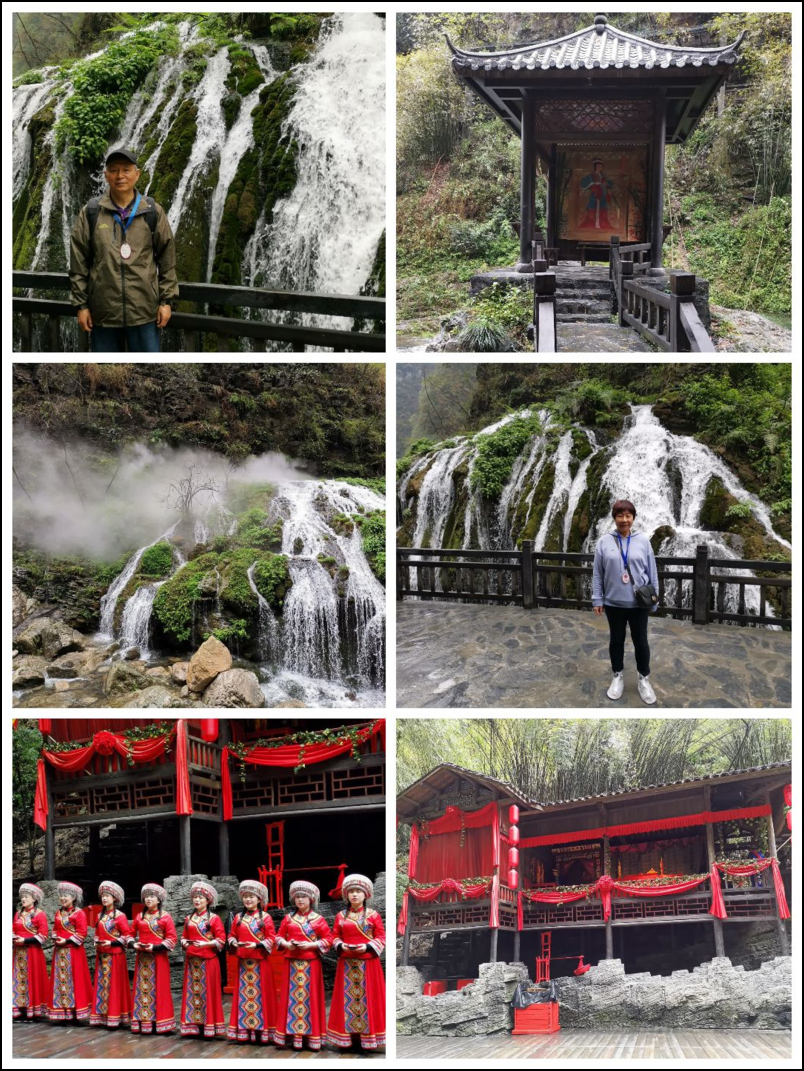
The households in the Three Gorges are divided into those living on the water, by the stream, and on the mountain, all of whom are Tujia ethnic group. Their lives are simple, ancient, and they worship nature.
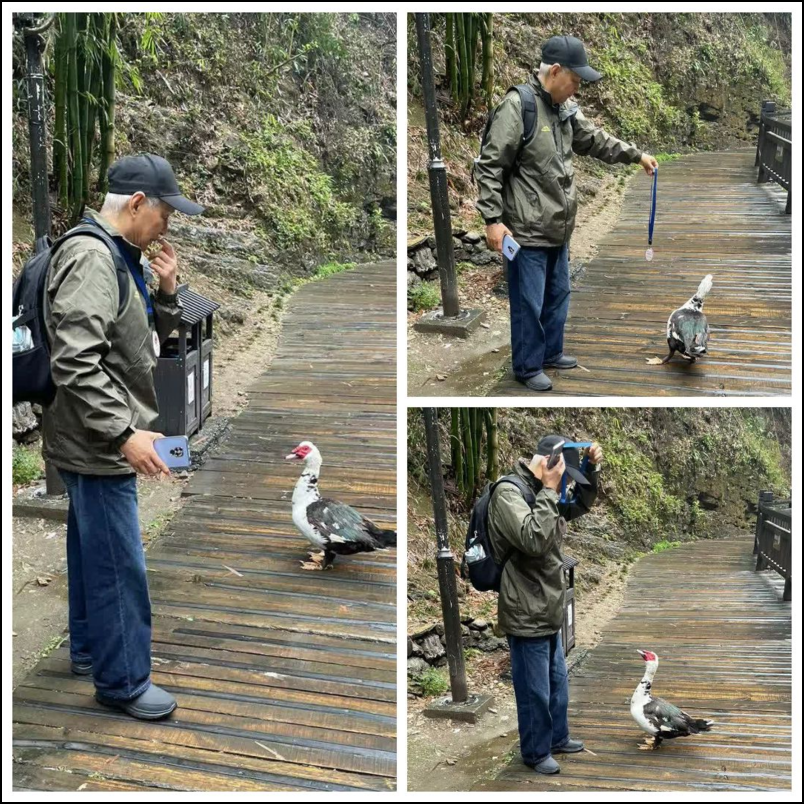
What should I do if I come across a Muscovy Duck blocking the way for food and not afraid of people on the scenic boardwalk, and happen to have nothing to eat?!
Walk along the mountain roads on both sides of Longjin Creek for about four to five kilometers in the scenic area. There are hanging coffins and monkeys on the mountains, and there are Tujia wedding performances on the stilted houses by the creek.
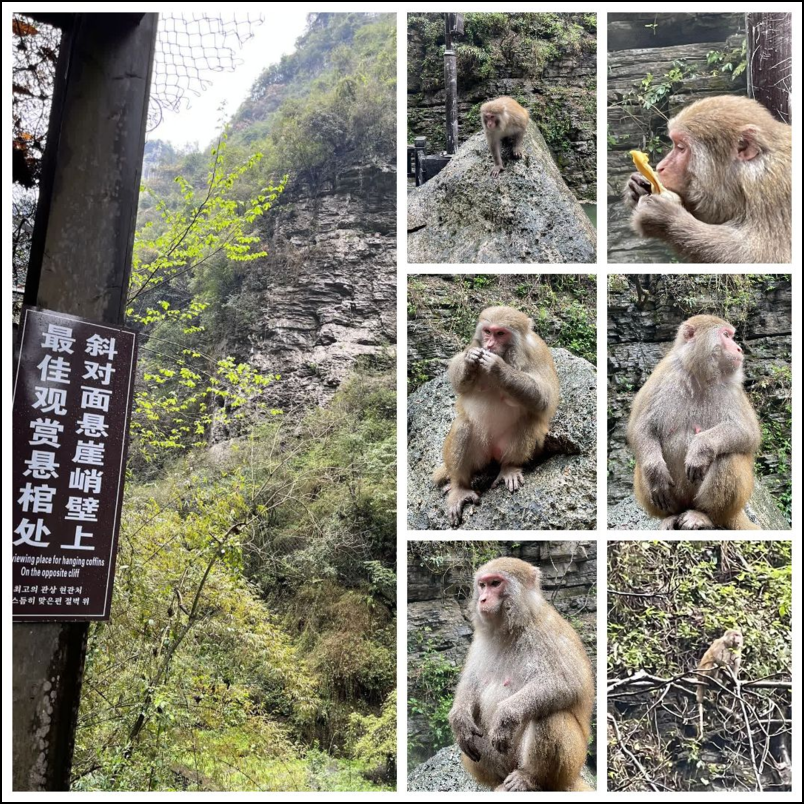
After reaching the mountain stream waterfall, I immediately wanted to turn back. The tour guide said to walk a little further and when I arrived at the pavilion, I could see the monkeys on the mountain. Then he continued to move forward.
There is a young man selling peanuts in the pavilion, priced at 10 yuan per small bag. The young man said that when he bought peanuts and called out to the mountain, the monkey would come down.
At this moment, other tourists also came over one after another. Some took out their own bananas, while I bought a bag of peanuts. The monkeys on the mountain had sharp eyes, and when they saw something to eat, they did run down one after another.
Monkeys are quite cute. Judging from their way of eating peanuts, they look like children.
It is estimated that these monkeys are not completely wild, but are kept in the scenic area. Perhaps the peanut seller is one of the keepers.
The idea of playing with a group of monkeys is good, as it can not only increase the popularity of the scenic area, but also increase economic benefits.
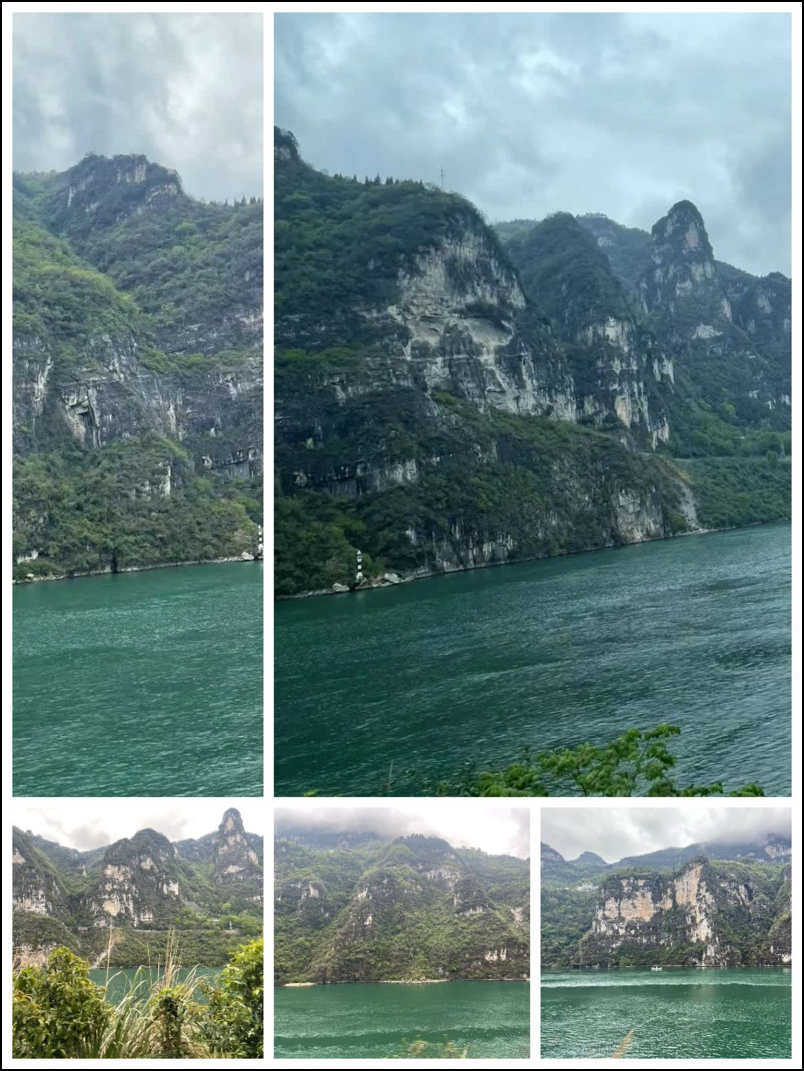
Erect the stone walls of the Xijiang River and cut off the clouds and rain of Wushan. A glance at the landscape of Xiling Gorge.
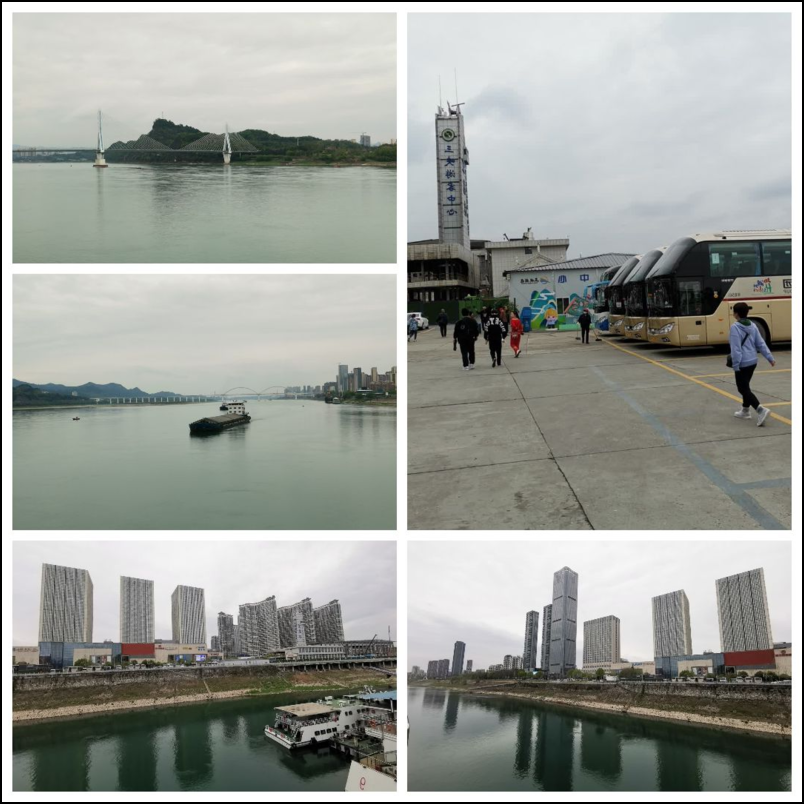
Yichang Port Jiu Wharf
After the visit to the Three Gorges, tourists were informed that the President's No. 6 ship had left the Sandaoping Pier and was heading towards the Yichang Jiu Pier.
Everyone left the scenic spot at 2:40 and took a bus around the roads on both sides of Xiling Gorge, enjoying the magnificent scenery. After passing through the main urban area of Yichang, it is equivalent to browsing the city's appearance.
The car drove for more than two hours and arrived at Jiu Wharf in Yichang. Only then did we see President 6 slowly approaching. After the ship docked and stopped, tourists boarded the ship, and everyone had a strong opinion about it.
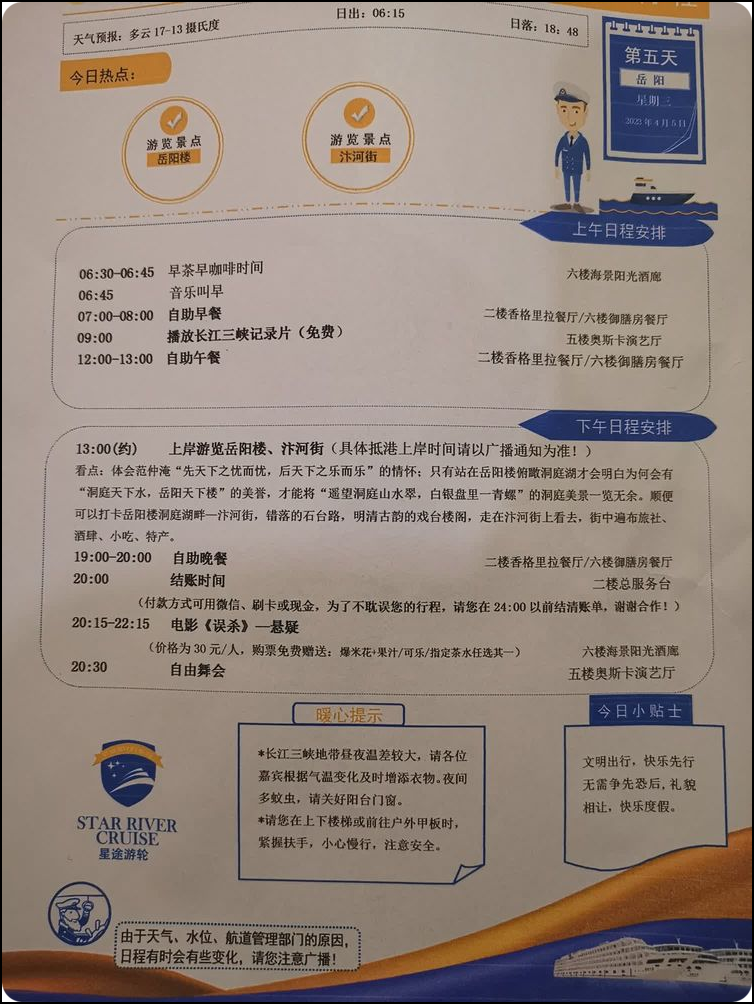
The fifth day of the President's Nine Day Tour on the Three Gorges Cruise
395 kilometers from Sandaoping Pier, Yichang Jiu Pier, and Chenglingji Pier.
At 9:10, the ship docked at Chenglingji Port in Yueyang City, Hunan Province. Chenglingji is the first rock formation in the middle reaches of the Yangtze River, and is known as one of the "Three Famous Rock formations of the Yangtze River" along with Yanzi Rock in Nanjing and Caishi Rock in Ma'anshan.
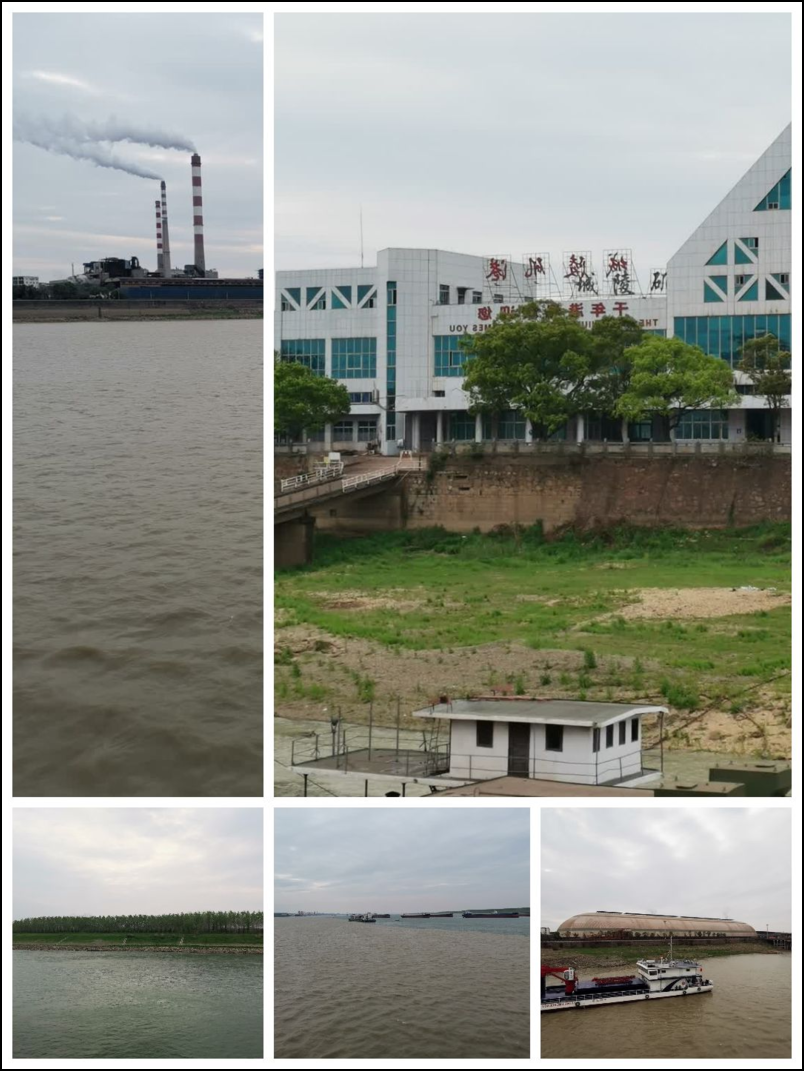
Chenglingji Port is one of the "Eight Great Ports of the Yangtze River" and the largest inland port in China. A comprehensive hub port for water land intermodal transportation and trunk branch connections in the middle reaches of the Yangtze River. The first gateway of waterways in Hunan Province and a national first-class port. Located on the right bank of the intersection of rivers and lakes 15 kilometers northeast of Yueyang City, 7.5 kilometers away from the Yueyang Tower District in the city center, facing Jianli County in Hubei Province across the river at the confluence of the Yangtze River and Dongting Lake.
The Yangtze River water here is already very turbid, and there are still many people fishing by the river near the port, which is a big gap compared to Sichuan's protection of the Yangtze River.
Today, the outdoor temperature is only 11 degrees, please add clothes and pants in a timely manner.
At 9:30, tourists gather at the service area on the second floor. The tour guide leads them ashore and takes a bus, which takes more than ten minutes to reach the Yueyang Tower scenic area.
Yueyang Tower is located on Dongting North Road in Yueyang Tower District, Yueyang City, Hunan Province. It is situated on the west gate of the ancient city wall of Yueyang, adjacent to the shores of Dongting Lake, overlooking Dongting Lake from below and Junshan from the front; Founded in the 20th year of Jian'an in the Eastern Han Dynasty (215 AD), it has been repeatedly renovated throughout history. The existing buildings follow the shape and layout of the reconstruction in the 6th year of Guangxu in the Qing Dynasty (1880). Since ancient times, it has been known as the "Water of Dongting Lake and the Tower of Yueyang", and is one of the "Three Famous Towers of Jiangnan" along with the Yellow Crane Tower in Wuhan, Hubei and the Tengwang Pavilion in Nanchang, Jiangxi.
The main building of Yueyang Tower is rectangular in shape, with a height of 19.42 meters, a depth of 14.54 meters, and a width of 17.42 meters. It is a three story, four column, flying eave, helmet top, and pure wooden structure. The four nanmu gold columns in the building run straight through the roof, surrounded by corridors, beams, rafters, and purlins that are mortise and tenon together to form a whole; The top is covered with glazed yellow tiles, with a solemn and elegant design.
Reciting Fan Zhongyan's "Record of Yueyang Tower" in front of Yueyang Tower has a unique artistic conception.
As for the core idea in this essay, is it "to worry about the people when living in a high temple, and to worry about the ruler when living far away from the rivers and lakes", or is it "to worry about the worries of the world first, and then enjoy the happiness of the world later"?
Regarding this, opinions vary from person to person, and the wise have their own views.
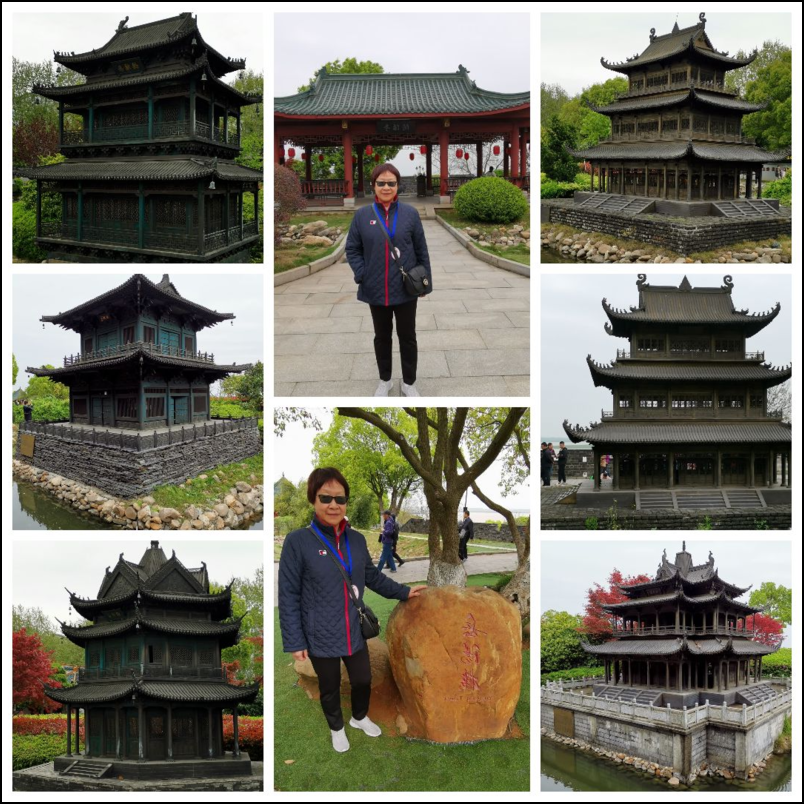
Copper miniature models of Yueyang Tower from various dynasties built in the scenic area

At 11 o'clock, leave the Yueyang Tower scenic area and wait at the square. After the tour guide comes out, inform them of the time to take the bus and return to the boat, and then take a stroll on Bianhe Street across from the square.
Bianhe Street was opened for trial on September 1, 2007. The street is over 300 meters long with a total construction area of 18000 square meters.
It is currently the most realistic antique style commercial street in China, with the most comprehensive design functions, the richest cultural heritage, the most beautiful scenery along the lake, and the largest area. It is a carefully crafted antique style commercial street based on the Yueyang Tower culture, Dongting Lake culture, and Baling culture.
The streets are filled with shops selling snacks, local specialties, handicrafts, and more.
Get on the bus at 12 o'clock and return to President 6.
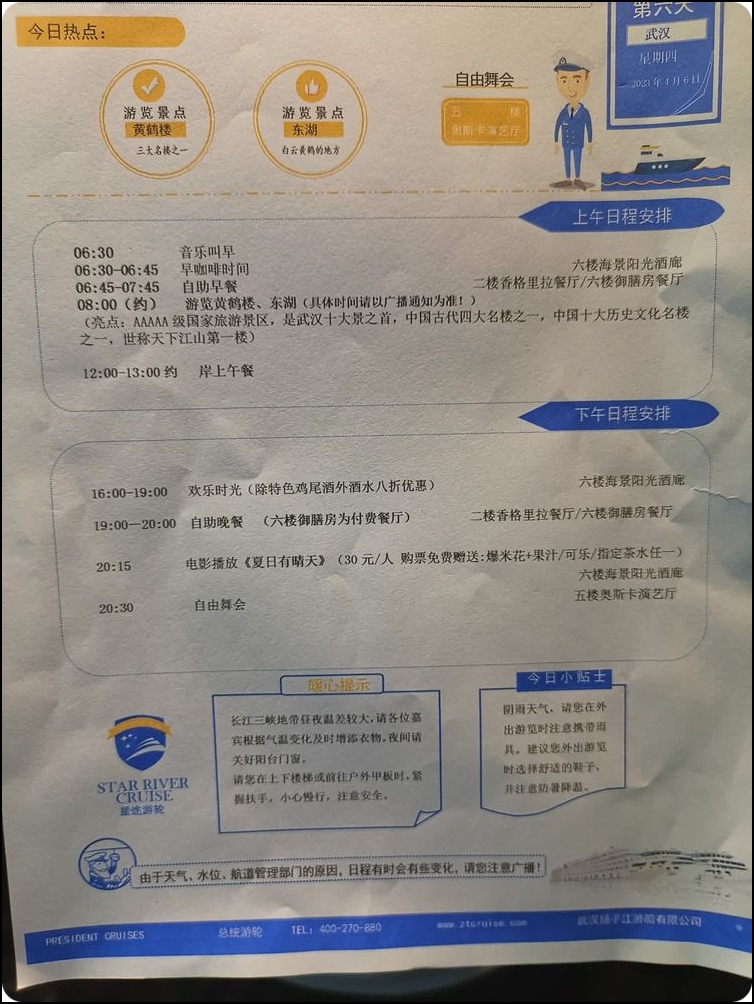
The sixth day of the President's Nine Day Tour on the Three Gorges Cruise
Chenglingji Wharf - Wuhan Wharf is 231 kilometers away.
After breakfast, tourists heading to Wuhan will pick up their luggage and leave the ship.
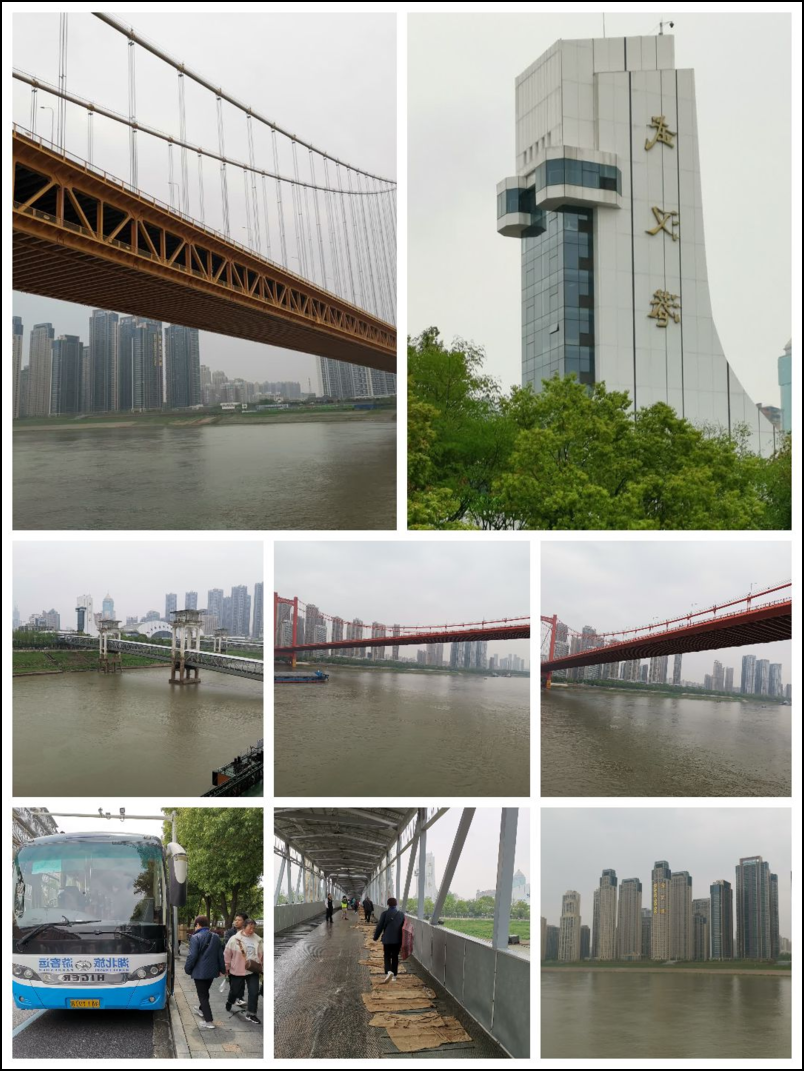
There are only 25 tourists left in Nanjing. They will gather on the second floor at 8 o'clock and take a bus to visit the Yellow Crane Tower.
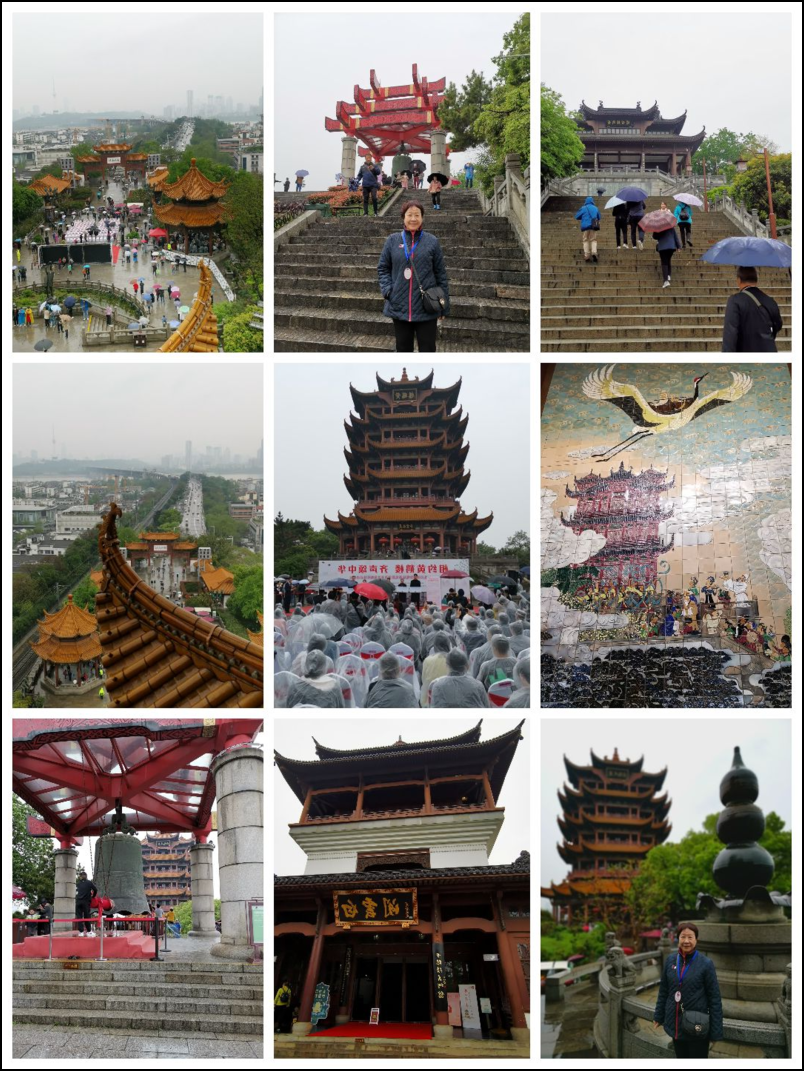
Visiting the Yellow Crane Tower scenic area, it kept raining and I used an umbrella throughout the entire journey.
The Yellow Crane Tower, located in Wuchang District, Wuhan City, Hubei Province, is situated on the top of Snake Mountain and adjacent to the Yangtze River for thousands of miles. It is a landmark building in Wuhan City; Founded in the second year of Huangwu in the Three Kingdoms period (223 AD), it has undergone repeated renovations throughout history. The existing building was designed based on the Qing Dynasty's "Tongzhi Building" and was rebuilt in 1985.
The main building of the Yellow Crane Tower is a four sided octagonal shape, reinforced concrete frame wood like structure, with an overall height of 51.4 meters, the bottom floor side width of 30 meters, the top floor side width of 18 meters, five stories of cornices, pyramidal roof roof, covered with golden glazed tiles, supported by 72 columns, and 60 tilt angles extending outward; Outside the building, there are copper yellow crane shaped buildings, Shengxiang pagoda, memorial archway, porch, pavilion and other buildings. The whole building is like a yellow crane, spreading its wings. The three characters "Yellow Crane Tower" were inscribed by Shu Tong.

Entering the scenic area, taking an electric scooter back and forth costs 10 yuan per person, climbing up to the fifth floor of the Yellow Crane Tower, and observing the furnishings on each floor. And browsed the main landscapes within the scenic area.
Recite two ancient poems from the Tang Dynasty, Cui Hao and Li Bai, about the Yellow Crane Tower in front of it.
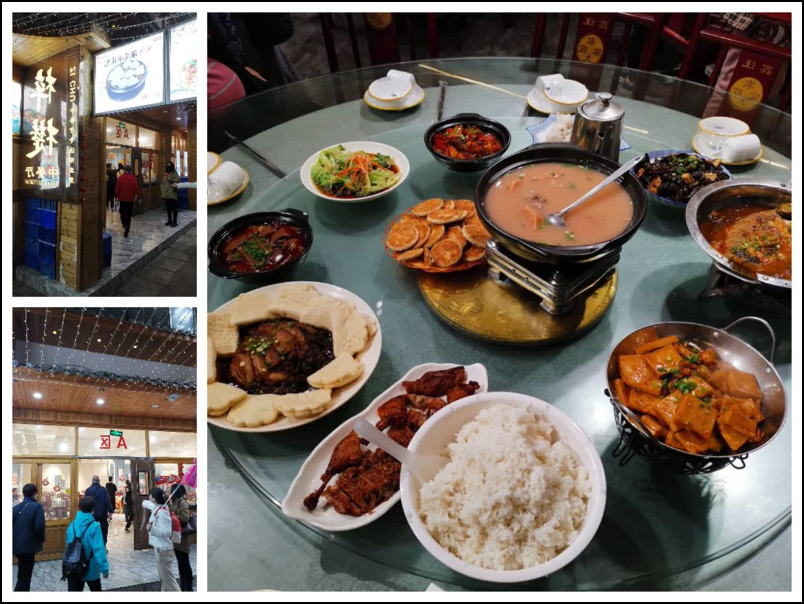
At noon, I had a meal at Zihao Chinese Restaurant at 232 Pengliuyang Road, Wuchang District, with 8 people per table. The Hubei style dishes were of average quality.
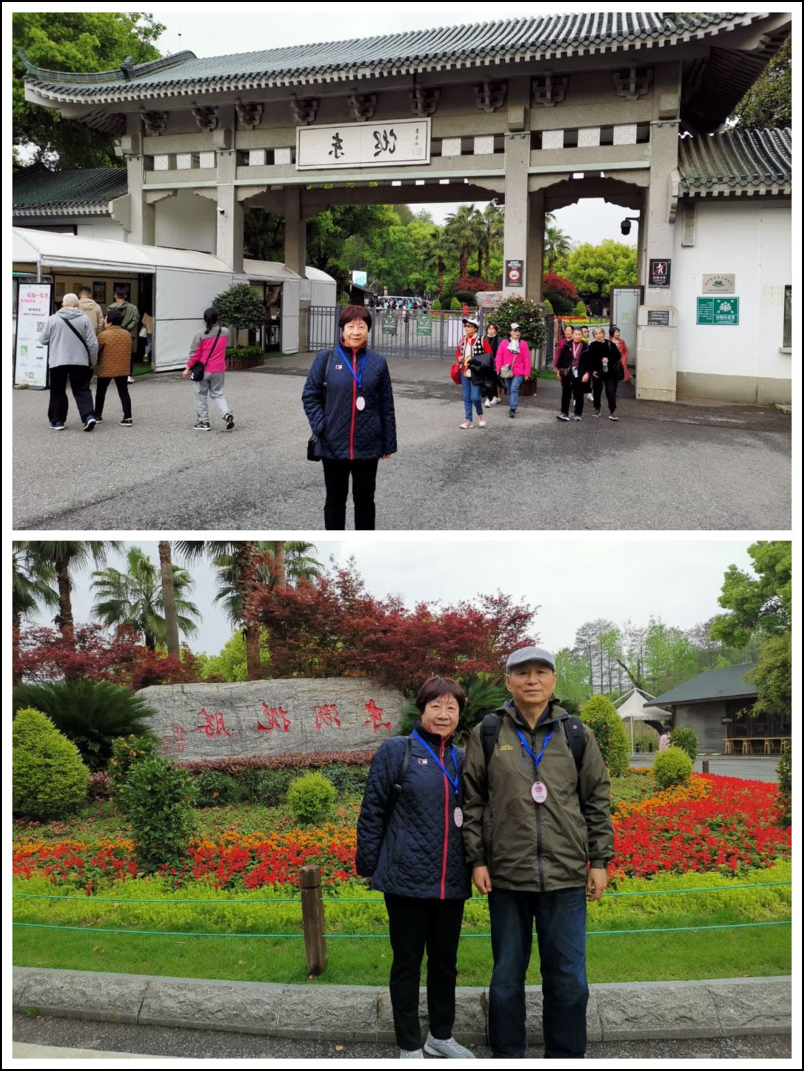
After dinner, the bus drove for more than 40 minutes and took everyone to visit the Tingtao Scenic Area in Donghu Park.
Donghu Lake is named after its location in the eastern part of Wuchang, Wuhan City. The scenic area covers an area of 88 square kilometers and consists of six areas: Tingtao, Moshan, Luoyan, Chudi, Baima, and Luohong.
It is now one of the largest urban lakes in China, with a water area of 33 square kilometers, six times that of West Lake in Hangzhou.
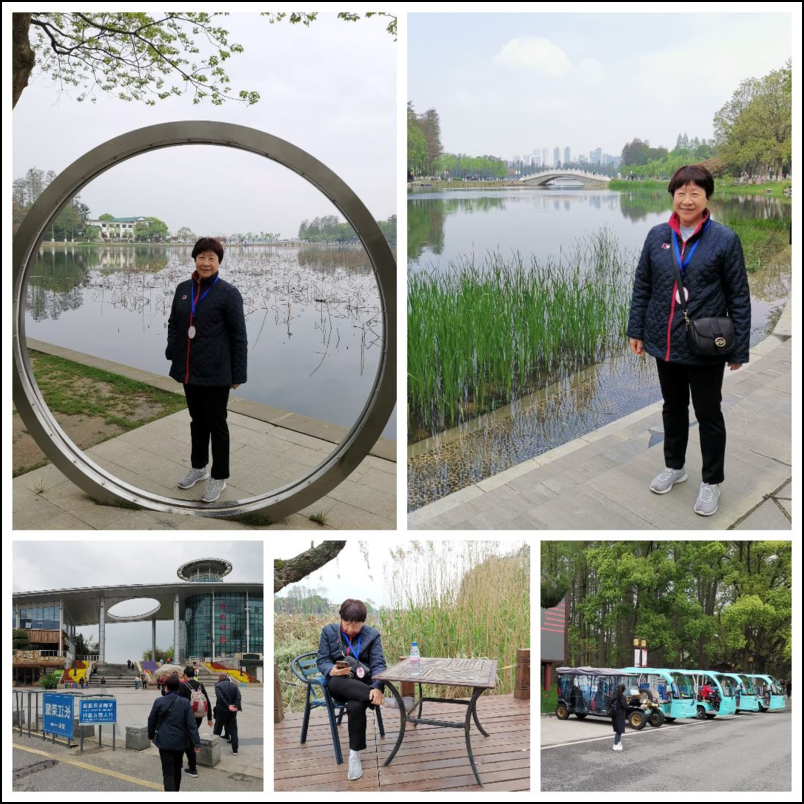
In order to enjoy the panoramic view of Donghu Tingtao District, we chose to take a scenic electric scooter and transfer for 22 minutes, which costs 30 yuan per person.
At 3:30 pm, take a bus back to Wuhan Port Terminal and arrive at the cruise room at 4 pm.
The seventh day of the President's Nine Day Tour on the Three Gorges Cruise
Due to channel control, the cruise ship is unable to navigate. I was stranded at Hubei Port last night and today.
In the morning, a temporary visit to the Hubei Provincial Museum was arranged, with the remaining 25 tourists led by cruise ship staff member Xiaolan departing.
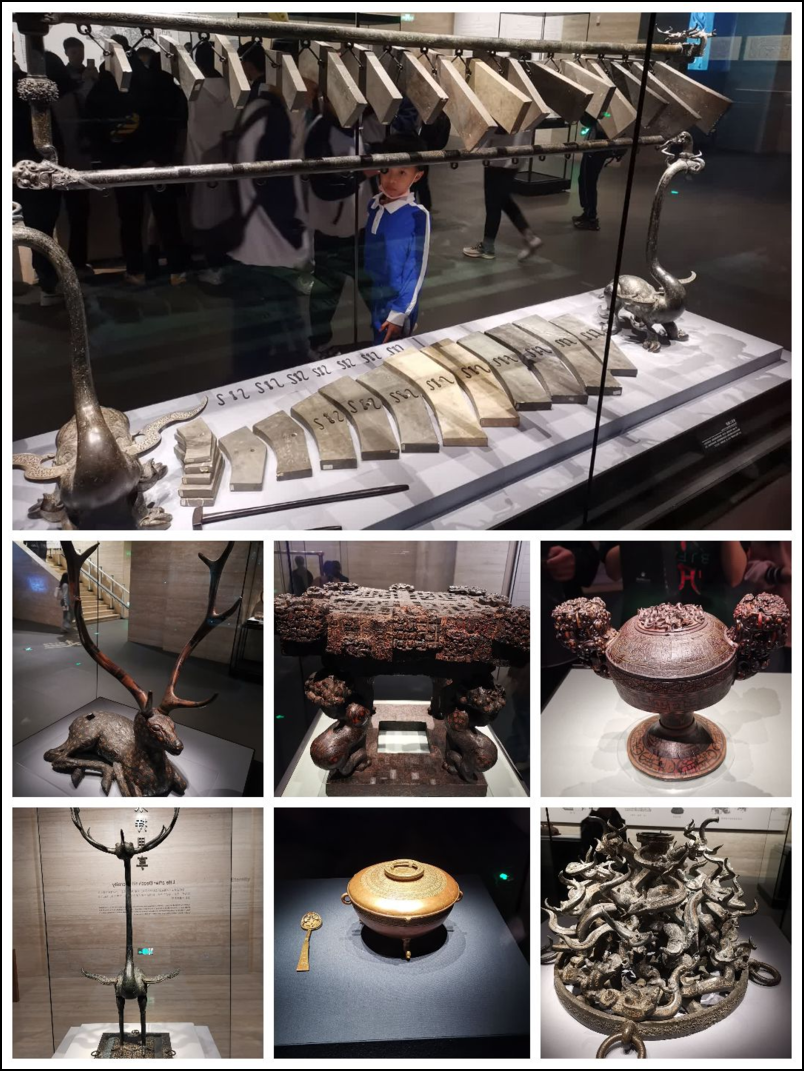
The Hubei Provincial Museum currently has a collection of over 260000 cultural relics, with bronze ware, lacquered wood, and bamboo slips being the most distinctive. Among them, there are 945 national first-class cultural relics and 16 national treasure level cultural relics.
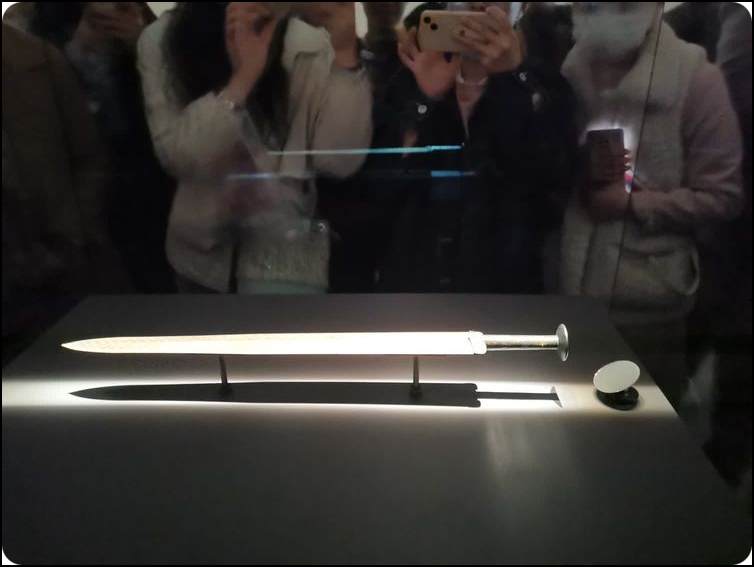
The most precious unearthed cultural relics in this museum are the sword of King Goujian of Yue and the bell of Marquis Yi of Zeng.
Yue King Goujian Sword: Unearthed from Tomb No.1 of Wangshan in Jiangling in 1965, it has been rust free for thousands of years.
The sword is 55.7 centimeters long, the handle is 8.4 centimeters long, and the width is 4.6 centimeters. The sword head is rolled out into a circular hoop shape, with 11 concentric circles cast inside with intervals of only 0.2 millimeters. The sword body is covered with regular black diamond dark grid patterns, and there is a bird seal inscription on the front near the grid that reads "Yue Wang Jiu (Gou) Shallow (Jian) Self acting Sword". The front of the sword frame is inlaid with blue glass, and the back is inlaid with turquoise.
The Goujian Sword of King Yue in the Spring and Autumn Period reflects the highest level of short weapon manufacturing at that time, and is known as the "number one sword in the world". It is a treasure among bronze weapons and has important value for studying the history of Yue and understanding ancient Chinese bronze casting techniques and characters.
Zeng Houyi Bianzhong: It was unearthed from the tomb of Zeng Houyi in Suixian, Hubei in 1978 during the Warring States period. The clock stand is 748 centimeters long, 265 centimeters high, and weighs about 4.5 tons.
The complete set of bells consists of 65 pieces, divided into three layers and hung in eight groups on a copper wood structure clock frame in the shape of a curved ruler. Each clock is capable of producing double notes in the third degree scale, and the entire set of clocks can play twelve semitones in unison, which can be rotated and modulated. The scale is commonly used in C major today, and can be played in pentatonic, sextonic, or heptatonic music.
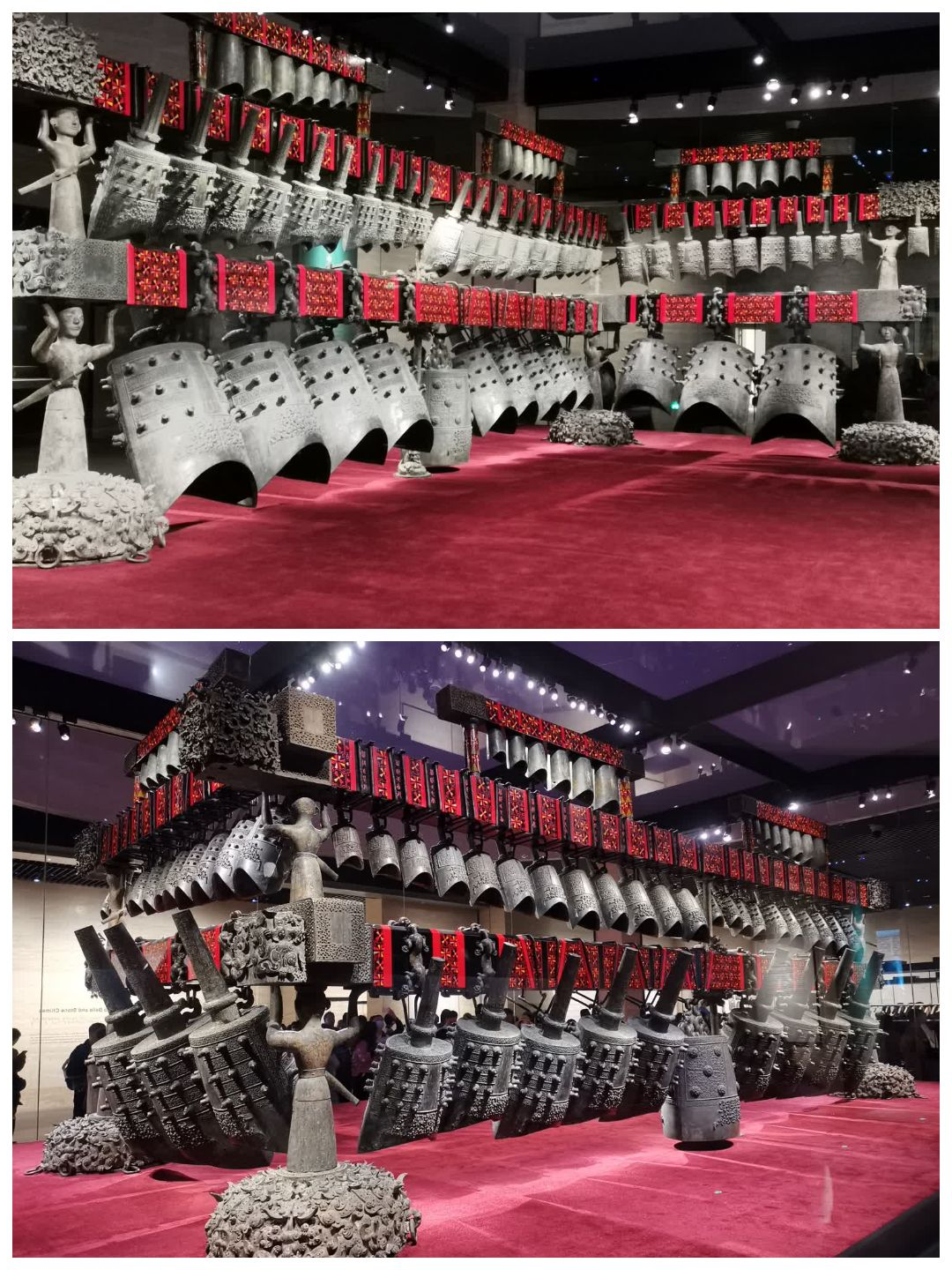
There are also pottery chickens and large round tripods from the Shang Dynasty, tiger seat bird frame drums, sixteen section dragon and phoenix pendants, and marigolds from the Warring States period, celadon lotus statues from the Northern and Southern Dynasties, music figurines from the Tang Dynasty, and golden phoenix crowns from the Ming Dynasty.
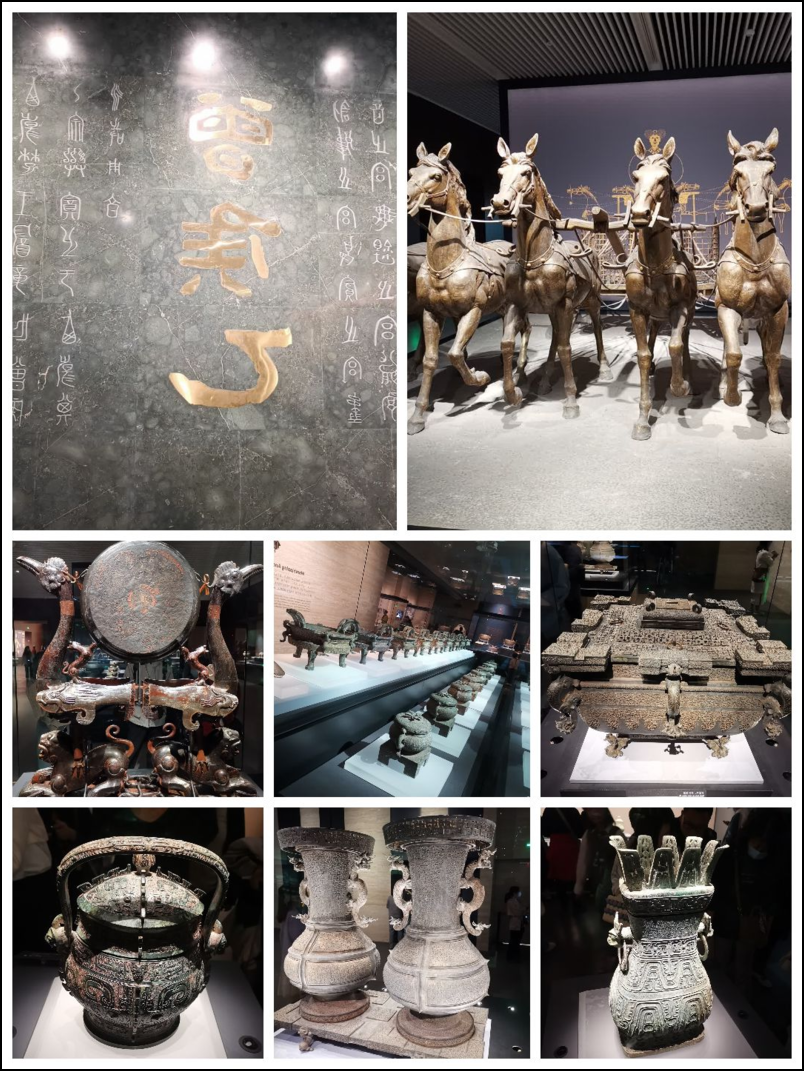
The eighth day of the President's Nine Day Tour on the Three Gorges Cruise
In order to meet the deadline, the cruise ship cancelled its stops at Jiujiang Port and Chizhou Port, as well as the plan for tourists to disembark for sightseeing, and directly opened at the Wumadu Port in Nanjing.
On the way, I saw that the water in the Yangtze River was very turbid, and there were often dead fish floating on the river surface. The larger ones weighed about two to three pounds, and more than ten of them formed small pieces.
I only saw a small finless porpoise swimming in waves in the center of the river once. Before I could take out my phone to take a photo, it quickly swam out of sight.
On April 8th dinner, a Beijing couple who had been dining with their desk mate for 9 days raised their glasses and wished them health, happiness, and joy before parting ways!

The three meals on the cruise ship were all quite good, the chef was skilled, the waiters did their best, and the tourists were satisfied with it.
Due to the control of the Yangtze River waterway, the original plan to visit Tengwang Pavilion could not be implemented after being stranded in Wuhan for one day.
Recalling the scene of visiting Tengwang Pavilion with my comrades and having a dinner at Tengge Autumn Wind Hotel on June 19, 2021, my heart was stirred and unsettled for a long time.
As the cruise ship passed through Jiujiang, he recited the full text of Wang Bo's first parallel prose "Preface to the Pavilion of Prince Teng" in order to gaze at Ji Huai from afar.
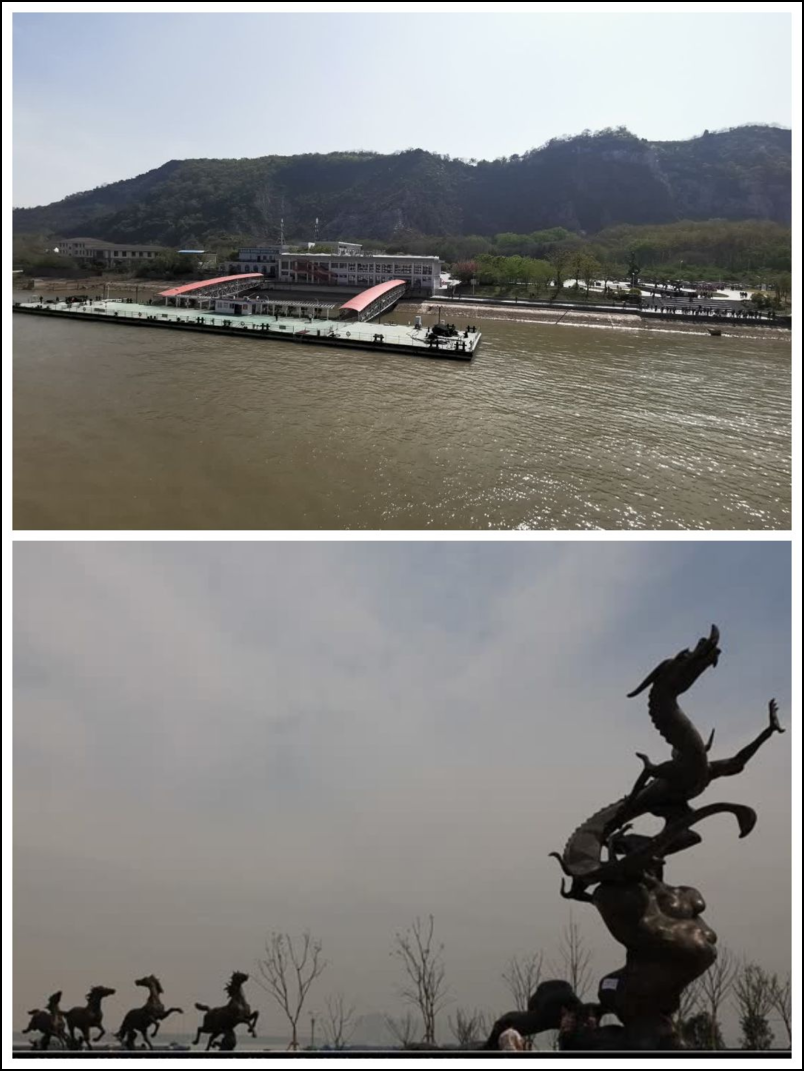
The ninth day of the President's 9-day tour on the 6th
On the morning of April 9th at 8 o'clock, the cruise ship arrived at the river surface of Wumadu Port in Nanjing. It waited for other cruise ships to leave before docking at 10 o'clock.
Wumadu Wharf is located on the north bank of Mufu Mountain in the Muyan Riverside Scenic Area of Qixia District, Nanjing City.
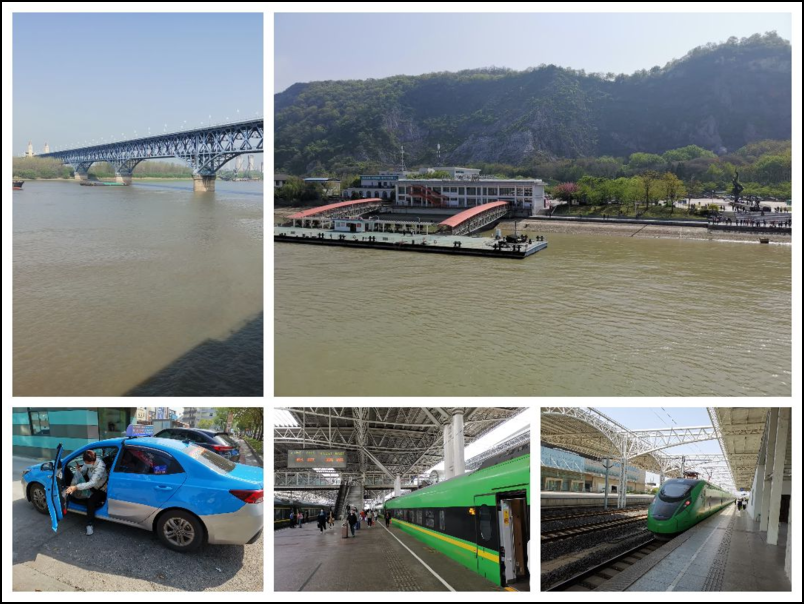
According to legend, after the "Rebellion of the Eight Princes" in the late Western Jin Dynasty, Prince Langya Sima Rui, Prince Xiyang Sima Yu, Prince Nandun Sima Zong, Prince Runan Sima You, and Prince Pengcheng Sima Hong crossed the river and arrived here. Among them, Sima Rui's mount suddenly turned into a dragon and flew away. Five horses floated across the river and one horse turned into a dragon, becoming a "good omen" before he proclaimed himself emperor.
In 317 AD, Sima Rui officially established the capital in Jiankang (now Nanjing) and founded the Eastern Jin Dynasty. Wumadu is also named after this.
After disembarking, take a taxi by the roadside from the dock to Nanjing Railway Station, and start the next stage of your travel itinerary.
Seven Wonders · Yangtze River (Chinese New Rhyme)
The Yangtze River, spanning thousands of miles, stands tall in the sky, and there are many heroes in China for generations to come;
The life of a rare person is a bit short, and the sunset glow is even redder.
Experience of Nine Day Yangtze River Cruise TourOverall feeling:
Good aspects
1. The navigation was safe. 2. The quality of the ship's meals is good. 3. The cabin hygiene is relatively good. 4. The service staff were enthusiastic and proactive, especially the restaurant staff did better.
There are problems
1. Failure to inform tourists of changes in the itinerary in a timely manner and lack of sincerity in the compensation plan. 2. The management personnel have poor organizational and coordination abilities, and when there are many people, they cannot achieve orderly travel when traveling ashore. 3. The service personnel are almost all beginners, lacking experience and knowledge, often asking questions without knowing, and their quality needs to be improved. 4. The cabin facilities are old and need to be repaired and replaced in a timely manner, such as toilet wrenches, shower sockets, etc. 5. There are too many charging items on board, such as watching movies, exercising, and using the chess and card room, all of which require additional fees.

After the production of this beautiful article was completed, I sent it to the "Little Treasure" at the cruise ticket booking center. After reading it, she wrote a passionate paragraph:
Looking at the city that I am familiar with in your words, I am deeply touched. The description is so realistic, and it turns out that my hometown also has another kind of beauty in the eyes of tourists.
The biggest feeling is moved, right!
I have been traveling for many years now, and occasionally I feel that my profession is too singular. Perhaps this can be considered as another kind of specialization for myself.
I will continue to serve more tourists in the future and I am honored to book a trip to the Three Gorges for everyone.
What I have been proud of in my career is to allow more guests to experience the beauty of different cities and different travel experiences.
The Three Gorges trip is indeed very comfortable in terms of travel methods, which is why I am more willing to recommend it to clients myself.
Safety, comfort, and happiness are the feelings that I hope every tourist will have after experiencing them.
However, different products or unexpected situations can indeed provide different experiences for tourists.
All the behind the scenes accumulated by everyone during their travel experience are precious treasures!
The same journey brings different rewards.
I envy you and your family, and I wish you and your loved ones a safe, sweet, and happy life in the future
Thank you, little treasure!
Sincere thanks to every worker who has worked hard for the prosperity of our country and the happiness of the people!
Three Gorges Cruise Ticket Reservation Center[www.sanxia-china.com]










 This is a condition of one layer.
This is a condition of one layer. The leadership members of President 6 cruise ship are six: captain, cruise ship director, customer service manager, recreation manager, restaurant manager, and head chef.
The leadership members of President 6 cruise ship are six: captain, cruise ship director, customer service manager, recreation manager, restaurant manager, and head chef. The life-saving equipment and fire-fighting facilities on board are relatively complete.
The life-saving equipment and fire-fighting facilities on board are relatively complete.
 The busy situation of the service desk staff when tourists check in.
The busy situation of the service desk staff when tourists check in.
 VIP glance at Executive Suite 503, with a total indoor area of 45 square meters including a balcony.
VIP glance at Executive Suite 503, with a total indoor area of 45 square meters including a balcony.



 At 7:30 pm, the announcement was made that tourists should gather at the second floor restaurant. Tourists who went to Nanjing, Wuhan, and Yichang should form groups to go ashore for tourism.
At 7:30 pm, the announcement was made that tourists should gather at the second floor restaurant. Tourists who went to Nanjing, Wuhan, and Yichang should form groups to go ashore for tourism. Boarding the dock with a Tujia female tour guide, tourists heading to Nanjing took bus No. 102 and drove for two hours to reach Xituo Ancient Town.
Boarding the dock with a Tujia female tour guide, tourists heading to Nanjing took bus No. 102 and drove for two hours to reach Xituo Ancient Town.
 Zhenzhong Yunti StreetThe original length was about 2.5 kilometers, with 1314 stone steps. Because the street resembles a giant dragon, spiraling down from the mountaintop like a ladder, it is the only ancient town with a stepped street layout perpendicular to the Yangtze River.
Zhenzhong Yunti StreetThe original length was about 2.5 kilometers, with 1314 stone steps. Because the street resembles a giant dragon, spiraling down from the mountaintop like a ladder, it is the only ancient town with a stepped street layout perpendicular to the Yangtze River. Street shops, statues, and performances make the ancient town full of vitality
Street shops, statues, and performances make the ancient town full of vitality Lunch was held at the "Jiangfeng Yanyun Restaurant" in the town at noon, with 10 people per table, 10 dishes and 1 soup, and rice. The dishes were decent.
Lunch was held at the "Jiangfeng Yanyun Restaurant" in the town at noon, with 10 people per table, 10 dishes and 1 soup, and rice. The dishes were decent.


 The most famous eighteen levels of hell
The most famous eighteen levels of hell



 The first picture taken early in the morning.
The first picture taken early in the morning. The ship docks at Fengjie Port.
The ship docks at Fengjie Port. The Golden 6 cruise ship closely followed my ship and docked outside at 7:50.
The Golden 6 cruise ship closely followed my ship and docked outside at 7:50.
 Baidicheng PierAlso known as Zhongyi Ferry.
Baidicheng PierAlso known as Zhongyi Ferry. Exit the White Emperor City Pier and enterZhongyi SquareThis newly constructed square covers an area of approximately 7000 square meters, nestled among numerous precious tree species such as osmanthus, camphor, and ginkgo, exuding a quaint yet grand atmosphere.
Exit the White Emperor City Pier and enterZhongyi SquareThis newly constructed square covers an area of approximately 7000 square meters, nestled among numerous precious tree species such as osmanthus, camphor, and ginkgo, exuding a quaint yet grand atmosphere.
 The mountain is steep with many steps, and the business of sliding poles is booming.
The mountain is steep with many steps, and the business of sliding poles is booming.
 The White Tower in the Baidicheng Scenic Area
The White Tower in the Baidicheng Scenic Area
 The pattern on the back of the ten yuan Renminbi and the view of Kuimen from Baidi City.
The pattern on the back of the ten yuan Renminbi and the view of Kuimen from Baidi City. After visiting the Baidicheng Scenic Area, return to the cruise ship.
After visiting the Baidicheng Scenic Area, return to the cruise ship.






 The Three Gorges Dam is the largest hydroelectric power station in the world and also the largest engineering project ever constructed in China. Construction officially began in 1994, and water storage and power generation began on the afternoon of June 1, 2003. The entire project was completed in 2009.
The Three Gorges Dam is the largest hydroelectric power station in the world and also the largest engineering project ever constructed in China. Construction officially began in 1994, and water storage and power generation began on the afternoon of June 1, 2003. The entire project was completed in 2009. The Three Gorges Dam has an elevation of 185 meters, a storage elevation of 175 meters, a reservoir length of 2335 meters, a static investment of 135.266 billion yuan, and the installation of 32 hydroelectric units with a single capacity of 700000 kilowatts.
The Three Gorges Dam has an elevation of 185 meters, a storage elevation of 175 meters, a reservoir length of 2335 meters, a static investment of 135.266 billion yuan, and the installation of 32 hydroelectric units with a single capacity of 700000 kilowatts. Take an electric scooter for 10 yuan to platform 185, take a close-up view of the ship lock, and leave at 10:20.
Take an electric scooter for 10 yuan to platform 185, take a close-up view of the ship lock, and leave at 10:20. After dinner, board the bus and drive to the parking lot of the scenic area, where tickets will be issued to enter the scenic area.
After dinner, board the bus and drive to the parking lot of the scenic area, where tickets will be issued to enter the scenic area. The Three Gorges Family Scenic Area is located in the most fantastic and magnificent Xiling Gorge in the Three Gorges of the Yangtze River, and is a national AAAAA level tourist attraction.
The Three Gorges Family Scenic Area is located in the most fantastic and magnificent Xiling Gorge in the Three Gorges of the Yangtze River, and is a national AAAAA level tourist attraction.
 The households in the Three Gorges are divided into those living on the water, by the stream, and on the mountain, all of whom are Tujia ethnic group. Their lives are simple, ancient, and they worship nature.
The households in the Three Gorges are divided into those living on the water, by the stream, and on the mountain, all of whom are Tujia ethnic group. Their lives are simple, ancient, and they worship nature. What should I do if I come across a Muscovy Duck blocking the way for food and not afraid of people on the scenic boardwalk, and happen to have nothing to eat?!
What should I do if I come across a Muscovy Duck blocking the way for food and not afraid of people on the scenic boardwalk, and happen to have nothing to eat?! After reaching the mountain stream waterfall, I immediately wanted to turn back. The tour guide said to walk a little further and when I arrived at the pavilion, I could see the monkeys on the mountain. Then he continued to move forward.
After reaching the mountain stream waterfall, I immediately wanted to turn back. The tour guide said to walk a little further and when I arrived at the pavilion, I could see the monkeys on the mountain. Then he continued to move forward.
 Yichang Port Jiu Wharf
Yichang Port Jiu Wharf
 Chenglingji Port is one of the "Eight Great Ports of the Yangtze River" and the largest inland port in China. A comprehensive hub port for water land intermodal transportation and trunk branch connections in the middle reaches of the Yangtze River. The first gateway of waterways in Hunan Province and a national first-class port. Located on the right bank of the intersection of rivers and lakes 15 kilometers northeast of Yueyang City, 7.5 kilometers away from the Yueyang Tower District in the city center, facing Jianli County in Hubei Province across the river at the confluence of the Yangtze River and Dongting Lake.
Chenglingji Port is one of the "Eight Great Ports of the Yangtze River" and the largest inland port in China. A comprehensive hub port for water land intermodal transportation and trunk branch connections in the middle reaches of the Yangtze River. The first gateway of waterways in Hunan Province and a national first-class port. Located on the right bank of the intersection of rivers and lakes 15 kilometers northeast of Yueyang City, 7.5 kilometers away from the Yueyang Tower District in the city center, facing Jianli County in Hubei Province across the river at the confluence of the Yangtze River and Dongting Lake.
 At 11 o'clock, leave the Yueyang Tower scenic area and wait at the square. After the tour guide comes out, inform them of the time to take the bus and return to the boat, and then take a stroll on Bianhe Street across from the square.
At 11 o'clock, leave the Yueyang Tower scenic area and wait at the square. After the tour guide comes out, inform them of the time to take the bus and return to the boat, and then take a stroll on Bianhe Street across from the square.
 There are only 25 tourists left in Nanjing. They will gather on the second floor at 8 o'clock and take a bus to visit the Yellow Crane Tower.
There are only 25 tourists left in Nanjing. They will gather on the second floor at 8 o'clock and take a bus to visit the Yellow Crane Tower. Visiting the Yellow Crane Tower scenic area, it kept raining and I used an umbrella throughout the entire journey.
Visiting the Yellow Crane Tower scenic area, it kept raining and I used an umbrella throughout the entire journey.
 At noon, I had a meal at Zihao Chinese Restaurant at 232 Pengliuyang Road, Wuchang District, with 8 people per table. The Hubei style dishes were of average quality.
At noon, I had a meal at Zihao Chinese Restaurant at 232 Pengliuyang Road, Wuchang District, with 8 people per table. The Hubei style dishes were of average quality. After dinner, the bus drove for more than 40 minutes and took everyone to visit the Tingtao Scenic Area in Donghu Park.
After dinner, the bus drove for more than 40 minutes and took everyone to visit the Tingtao Scenic Area in Donghu Park. In order to enjoy the panoramic view of Donghu Tingtao District, we chose to take a scenic electric scooter and transfer for 22 minutes, which costs 30 yuan per person.
In order to enjoy the panoramic view of Donghu Tingtao District, we chose to take a scenic electric scooter and transfer for 22 minutes, which costs 30 yuan per person.

 There are also pottery chickens and large round tripods from the Shang Dynasty, tiger seat bird frame drums, sixteen section dragon and phoenix pendants, and marigolds from the Warring States period, celadon lotus statues from the Northern and Southern Dynasties, music figurines from the Tang Dynasty, and golden phoenix crowns from the Ming Dynasty.
There are also pottery chickens and large round tripods from the Shang Dynasty, tiger seat bird frame drums, sixteen section dragon and phoenix pendants, and marigolds from the Warring States period, celadon lotus statues from the Northern and Southern Dynasties, music figurines from the Tang Dynasty, and golden phoenix crowns from the Ming Dynasty.



